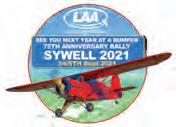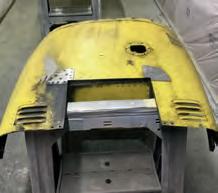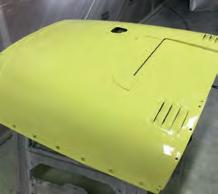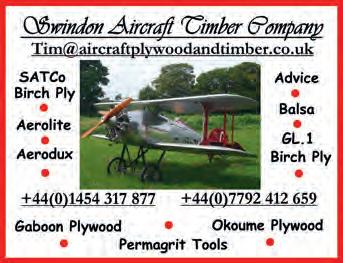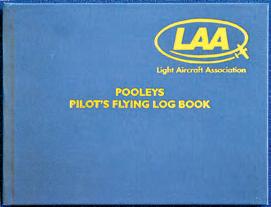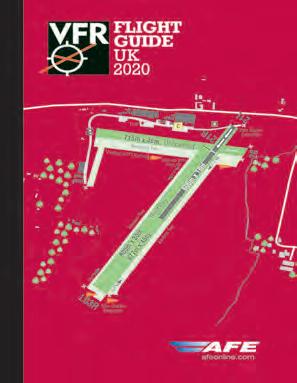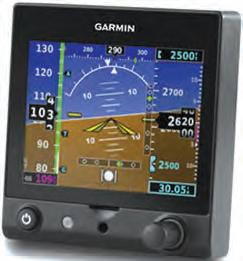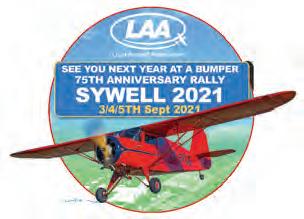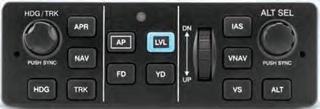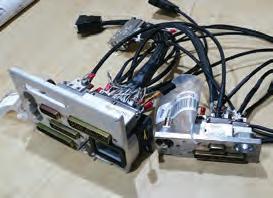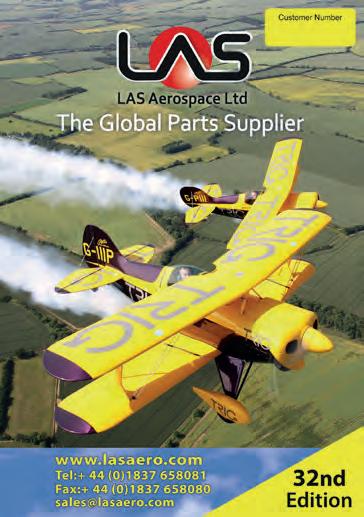














That now famous 1976 newspaper headline – Phew what a scorcher! – certainly came to mind when we had the best part of a week with 35° temperatures over some parts of the country in mid-August. I must admit it’s too much for me, and unless you can go high, even flying in such conditions becomes somewhat arduous.
I recall a trip to the Rioja Valley some years ago in unprecedented high temperatures and an overnight stop at Zaragoza. We cruise climbed out of Girona to 7,000ft, bliss after the scorching heat of the apron as we refuelled, but descending into Zaragoza the heat coming through the air vents was like a hair dryer. When we went out that evening for dinner, the temperature on a time/temp display was still showing 40°.
It’s not often we have to start worrying too much about density altitude in the UK, but Martin Ferid certainly had to consider it in France, as he recalls in the tale of a post-lockdown trip to Chambéry. Plans for a possible side trip to the EAS & EASA Swiss fly-in at the short, hot, high and windless Langenthal were sensibly shelved. There are also some important changes in the prior notice requirements for French Customs that Martin alludes to.
The flight test this month is of a delightful DH85 Leopard Moth, which has had an interesting and quite busy life, although before being acquired by Peter Vacher it had spent a long time in storage and was in need of restoration. This was superbly carried out over seven years by
Martin Honeychurch of the Newbury Aeroplane Company, the end result being a machine of utter beauty to behold. Now owned by Cliff Hawkins, the aircraft is, considering its age, surprisingly ‘usable’, seemingly having few, if any, quirky attributes.
Following our earlier article on electric aircraft a couple of months ago, Nick Sills of Contra Electric Propulsion Limited discusses the merits of contra rotating propellers with electric power. His CRPS 225 180hp continuous, 300hp peak power twin motor contra prop power plant will hopefully soon be powering a Harmon Rocket here in the UK. It is unfortunate that such advanced technology from a small UK company is finding it so difficult to attract UK funding in a field that is championed as so vital for our future transport systems.
Now that a number of fly-ins are taking place, it was great to hear that Lundy Sunday was blessed with reasonable weather and 80 aircraft ventured across the Bristol Channel. My thanks to Pete White for his report and to Neil Wilson for the pictures. It is a fly-in venue I have yet to experience, hopefully it will be on the agenda for next season!
Take care and be safe. Brian.
 Brian Hope
Nick Sills’ twin electric motor and contra rotating propeller system undergoing testing.
Brian Hope
Nick Sills’ twin electric motor and contra rotating propeller system undergoing testing.

Ihope you and yours are well and you have been able to enjoy what remains of our flying summer in some way, shape or form. So much of what we have come to expect and anticipate in our lives has changed dramatically, and will most probably never go back to the way things were – and that includes your Association. Whether that be ways of working in the office, engagement events with our members and just generally how we go about enjoying our passion, the ways of old need to be re-thought.
On that subject, and thinking ahead to our forthcoming Annual General Meeting in October, our recent modus operandi involved an autumnal flight or drive to Sywell, the presentation of awards, a guest speaker or two, lunch and then the actual AGM followed by questions and answers from the floor. Sometimes it was a bit of a challenge getting a quorum (1% of the membership), in which case the Chairman could observe that the meeting wasn’t quorate, allow 20 minutes to see if more members turned up and could then continue with the meeting. It’s all in our rules, by the way.
In our new and ever changing world, you can undoubtedly spot a few obstacles in trying to repeat the process this year, so the board discussed this at length and has agreed that for the October AGM, we will need to do things differently.
The first thing to note is that the physical meeting will consist of a small representative group of board members, most probably Steve Slater and I as a minimum, to conduct the AGM in a socially distanced room at Turweston.
For our members then, we are making arrangements to conduct our AGM via the Zoom conference calling facility and will expand the attendance capacity limits over and above what you
normally get to cater for, with many more LAA members joining from home.
In fact, we think that our usual physical attendance will probably be far exceeded, as AGM delegates will not have to travel nor think about the weather for the flight home.
We are also working on an attendee counting mechanism and recording member feedback to supplement the conference facility. Given these benefits, we would like to include this provision for future AGMs beyond this year’s restrictions so that we can welcome members living a long distance away from Sywell in future, as well as welcoming all those that can make it physically. It will hopefully be the best of both worlds and an opportunity for those members who we don’t normally see at the AGM to get involved.
The agenda for the day is still being worked on however, and because we need to comply with our existing rules I will still have to wait 20 minutes to start the meeting, so while everybody who wants to join the meeting is online Steve can use the time to provide his CEO’s report.
There will also be some items to vote on, including writing our ability to go electronic into the rules, and these will be set out in a proxy voting form attached to the October edition of the LA magazine.
Proxy voting is doubly important this year because there will be no meaningful physical vote to count. Could I also use this opportunity to request that any motions that members wish to put forward are sent in to the office at Turweston (office@laa.uk.com) by no later than 5 September to comply with our 42 day notice rule – many thanks.
Please bear with us as we negotiate this journey, I’m confident we will get the job done and I am sure we will identify improvements as we go along.
Safe flying!
06 NEWS
Armstrong Isaacs bursaries 2020, Virtual AGM and Richard Warriner obituary
10 PROJECT NEWS
Beagle B121 Series 1, Kitfox Mk 7, Sherwood Scout, Cleared to Fly and New Projects
16 ELECTRIC AIRCRAFT
Electric powerplant pioneer Nick Sills explains the benefits of contra rotating propellers with electric motors…
21 PIERRE ROBIN
We celebrate the legacy left to light aviation by Pierre Robin
22 RALLIES REVISITED
Sadly no Rally for 2020 so here’s a brief reminiscence
28 FLYING ADVENTURE
Martin Ferid weighs up the pros and cons about flying to Europe as COVID-19 restrictions fluctuate with changing circumstances
34 LANDING VOUCHERS
Your free landings, discounts and offers for October 2020
36 FLIGHT TEST
Clive Davidson gets a history lesson when he flies the vintage De Havilland DH85 Leopard Moth G-ACMA…
44 LUNDY SUNDAY
After a season of disappointing cancellations, the Lundy Island Fly-in went ahead with 80 aircraft flying in to this unique venue, as Pete White reports…
46 COACHING CORNER
LAA National Coach, Chris Thompson, discusses currency versus. proficiency
50 SAFETY SPOT
Malcolm looks at the importance of close inspection of control systems and flight control attachments
56 STRUTS4U
Anne Hughes profiles the activities of the Struts, making good use of social media
58 MEET THE MEMBERS
We talk to Toby Willcox, aircraft engineer and microlight and light aircraft pilot…
62 CEO THOUGHTS
Steve Slater considers airspace conundrums – again…

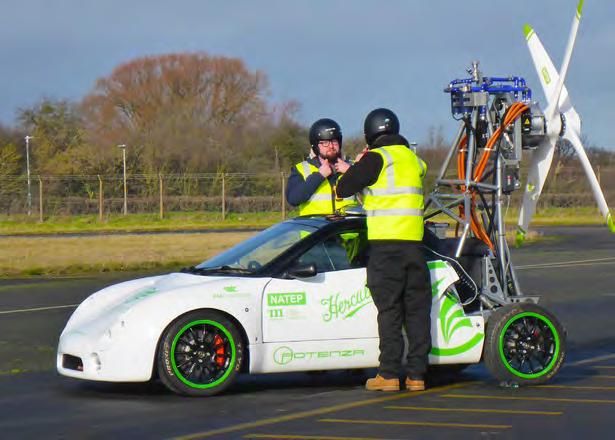
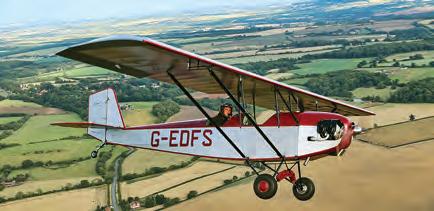

Plenty more news is available on the LAA website at www.laa.uk.com check it out every day!
The Association’s 2020 Armstrong-Isaacs PPL bursary scheme, aimed at supporting student pilots under the age of 30, is now accepting applications. Five bursaries of £1,500 are being offered to support young pilots already in training. The additional funding will help them complete their courses at a time when money often starts to run out.
“These funds offer support to young pilots who have already demonstrated their commitment to flying‚” said LAA CEO and Armstrong-Isaacs trustee Steve Slater. “The latter stages of the PPL are particularly financially challenging, with longer cross-country flights requiring greater outlay in aircraft rental costs. These bursaries may enable students to complete their training, when perhaps they may otherwise have had to suspend or even forego the completion of their course and this is going to be particularly important in the post-Covid era.”
To qualify for a bursary a pilot should be under 30 years of age, have completed a minimum of two hours solo training and have gained the necessary medical and ground qualifications to

continue their training. To apply, complete the form which can be downloaded from the LAA website via the LAA Bursaries on the home page, and email it to office@laa. uk.com with the subject title Armstrong/
Pilots flying into Turweston are requested to avoid overflying Abbey House by not following the fire break in Whitfield Wood when departing 09 but extending to beyond the wood before turning. It appears that the firebreak is incorrectly shown on many online charts as the arrival and departure route. The chart
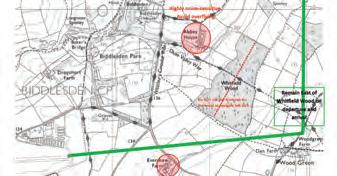
Following a spate of post-lockdown landing mishaps in May and June –around 70% of the GA unit’s Occurrence Reports for the period – the CAA has recently issued some pilot advice on landings.
The advice is available online at https://tinyurl.com/y6c2w8kx
You can never get too much advice on flying technique so please read and digest this useful information – many of us are a lot rustier than we think!
Becky Norman, a 2019 bursary recipient, has made good progress on her cross-country training since lockdown and is very close to gaining her PPL
Isaacs Bursary. The deadline for applications is Friday, 30 October 2020. Following a selection process, successful recipients will be contacted in December.
In concert with the Armstrong Isaacs bursary scheme, the Vintage Aircraft Club (VAC) has launched its 2020 Liz Inwood Taildragger Scholarship which enables a PPL, NPPL or LAPL licence holder under the age of 35, to gain five hours of tailwheel instruction to allow them to progress to vintage, classic or other tailwheel types.
The Scholarship is named in memory of the late Tiger Moth pilot and flying instructor Liz Inwood and is funded by donations from VAC, the LAA and the Inwood estate. It enables the use of a suitable flying school aircraft and instructor, selected to suit the recipient’s location. An application form can be downloaded from the VAC website www.vintageaircraftclub.org.uk
We’re happy to announce the addition of two new types to the list of ‘LAA accepted’ aircraft with the issuing in August of the initial Permits to Fly to Jim Edgeworth’s Glastar Sportsman and Bill Sweetnam’s RV-14.
The Glastar Sportsman is a slightly stretched version of the well-established Glastar, intended as a 2+2 variant of the high-wing two-seater. Like the Glastar, the Sportsman’s strut-braced wings are designed to fold and both nosewheel and tailwheel configurations are available – it only takes a day or two to swap undercarriages to reconfigure. Jim’s example, G-CLFM, sports a Lycoming IO-360 engine with Hartzell constant speed prop and was finished in 2019 and first flown from Fishburn by Paul Johnson before being given an independent handling check by Ivan Shaw.
The aircraft was found to be exceptionally benign-handling, perhaps in part because of

the vortex generators along the top surface of the otherwise clean, high aspect-ratio wing.
The Sportsman is Jim’s third homebuilt project, having previously built an RV-6A and a Bristell NG5. At present, the LAA is only able to clear the Sportsman as a two-seater with
Other recent developments include the granting of the first LAA Permit to a Yak 52, in the form of Popham-based G-YAKX, headed up by Rob Rowe. Several other 52s are already lined up to follow in KX’s footsteps. The Yak types have previously only been issued Permits to Fly by the CAA, but a progressive transition to LAA supervision is planned for these types, using only LAA Inspectors already fully familiar with the types and the many unusual nuances arising from their ex-military Eastern Bloc origin.
We have also recently cleared a rebuilt Stampe to fly that’s been re-engined with a Czech-built LOM engine in place of the original Renault or Gipsy Major, using a
The Van’s RV-14 is the Aurora, Oregon-based company’s latest two-seater offering, which shares the familiar side by side seating and low-wing layout of the RV-6 and RV-7 and also employs a similar all-aluminium alloy riveted structure. Like the Sportsman, there are tailwheel and nosewheel versions available. In this case a change on configuration means a fair amount of work, as well as, like the other Van’s designs, the addition of an ‘A’ to the designation if the third wheel’s at the front. The RV-14’s selling point is that it’s more generously sized than its other two-seat siblings, intended for pilots of a larger stature. Equipped, like the tandem-seat RV-8, with baggage
exceptional baggage carrying capability, but it’s hoped that in due course it’ll be possible to clear it as a four seater – or, more accurately, a 2+2. The Sportsman is available in kit form from Glasair of Arlington, USA, where it is now a well-established design, combining easy handling and short field capability with a very respectable performance in its class, having an advertised 140kt cruise speed and 2,000ft/ min rate of climb. Like the Glastar, the Glastar Sportsman has riveted aluminium alloy wings and tail surfaces, and a composite fuselage with a welded steel tube frame reinforcing the forward section and providing the attachments for wing, struts, engine and undercarriage.

conversion engineered by Andy McLuskie and John Tempest. This is just one of a trio of Stampes that have been cleared for flight for the first time by the LAA in recent months, along with the usual steady trickle of
Chipmunks, Tiger Moths and Austers. Rarer among recent additions to the vintage fleet have been Mark Hales’ Miles Messenger G-AIEK and Roy Palmer’s prototype DH80A Puss Moth G-AATC.

compartments both in front and to the rear of the cockpit, there’s scope for carrying a massive payload without squashing your suitcases or compromising the cg limits.

Bill’s G-ORVS is fitted with the standard 210 BHP Lycoming IO-390 engine and, like the Sportsman, a Hartzell constant speed propeller. Initially test flown by local pilot Steve Ayres from a strip near Colerne, the RV-14’s independent flight handling evaluation was undertaken by ex-CAA test pilot Chris Taylor, who found the handling characteristics met the requirements with flying colours, and in fact, he was able to give the type a clean bill of health as a candidate for future night-IFR clearance.
The Annual General Meeting of the Light Aircraft Association Limited is traditionally held at Sywell Aerodrome on the third Sunday of October each year.
This year, due COVID-19 restrictions, we’re sure you’ll appreciate that it is highly inadvisable, if not illegal, to host a ‘face-toface’ meeting.
We will therefore host an online AGM at 10am on Sunday 18 October using the popular Zoom teleconference application, which we have recently used to successfully host a series of virtual ‘pub nights’ and other LAA meetings. The link to the meeting will be https://bit.ly/31dE3nP (Zoom meeting ID: 854 0107 1535) with Passcode: 552713.
Not only will our Virtual AGM allow us to fulfil the usual formalities of an AGM and meet our mandatory requirements as a Limited Company under revised Government guidelines, but once the formalities are completed we will allocate time to a Member Forum. This will allow as many members as possible to quiz Board members and LAA staff, and to discuss some exciting proposals for 2021, our 75th Anniversary year.
We’ll certainly miss the social element of the usual gathering at Sywell, but the safety of members and staff is paramount.
We still look forward to a more regular meeting in 2021. However, now the technology is available, we plan to keep an
electronic element to enable more members to become involved in future AGMs and will amend the necessary rules to accommodate this.
A full list of Motions and an AGM Schedule will be circulated with the October Light Aviation magazine and online. All voting will be ahead of the meeting by proxy, via a form carried with the magazine. Notices of Motion of any kind for the AGM must therefore be received at LAA HQ no later than Saturday 5 September 2020
In the meantime, if you have any questions or comments for both the AGM or the Member’s Forum, please do not hesitate to get in touch with us. You can do so via office@laa.uk.com
Michael Evans is carrying out some research into the serious issue of Infringements with a view to developing mitigation strategies for pilots. He is struggling to get responses from those who have unfortunately found themselves at the wrong end of a CAA letter,so please let’s show that LAA members take this issue seriously and help him to help us. Thank you, Ed.
Dear Editor. According to the CAA, in 2019 (January-November*) there were 1226 infringements, an average of four a day throughout that period. The numbers do, of course, increase in the summer and reduce during the winter. The number of infringements has shown a slight upward trend over the past few years – 1,031 in 2016; 1,162 in 2017; 1,358 in 2018 –although there appears to be no simple explanation for this.
Traditionally, the CAA has recorded causes of infringements, that is those factors that are said to lead to an infringement or other incident. These include in no particular order, navigation errors such as misreading a chart or misidentifying
ground features, poor or incorrect pre-flight planning, weather problems including loss of visual cues, and pilot workload.
But these factors are only part of the story, they only tell us ‘what’ happened leading to the infringement. Assuming that pilots do not set out to infringe, then just about all infringements may be said to involve pilot error because the intended outcome has not been achieved. But why do pilots make such errors that go against their training and instincts? What are the factors that explain pilot behaviour when carrying out a course of action that may lead to an incident such as an infringement?
Are all pilots who infringe somehow negligent, careless or even complacent, as some may think (see Let’s get rid of the bad pilots by Sidney Dekker**)? Or are there other contributory factors for the errors made by pilots that lead to infringements? And if there are other issues, what can we learn from them?
As part of my research I have interviewed a number of pilots who have infringed controlled airspace. It is at an early stage, but already the contribution of distraction to pilot error is becoming quite a major factor.
What is of particular interest is the variety of distractions that can lead to error, including the various ways that passenger focus can, among other things, divert attention from flying the aircraft, how ‘press-on-itis’ can, and does, catch us out and the role of external factors in distorting our decisionmaking.
The results will be published in due course and I hope it will help pilots understand better how errors may be made and provide mitigation strategies to avoid repeating the mistakes of others.
However, I do need further participants. If anybody reading this has infringed controlled airspace in the past year or so, or knows someone who has, would like to take part – entirely anonymously and in total confidence – or would simply like to discuss it with me, then do please make contact on: email: michael.evans.17@ucl.ac.uk mobile: 07914 815857
Thank you,
Michael Evans.
* airspacesafety.com/facts-stats-andincidents
** www.skybrary.aero/bookshelf/books/1232. pdf ■
Recreational flying, indeed, General Aviation lost a true ambassador on 4 August with the tragic death of Richard Warriner in his Rans S-6, G-BUWK, at Heathfield. We are all privileged to meet special people in our lives, and those fortunate to have met Richard knew they were in the presence of a man whose passion for flying and encouraging others to fly knew no bounds.
Richard epitomised the LAA’s raison d’etre of Flying for Fun and he wanted the world to share the joy of light aviation, often taking anybody he met for a ride in the Rans, including complete strangers who happened to be walking past the airstrip. He was also a regular at events up and down the country flying sick or disadvantaged youngsters – Starlight, Young Aviators and Project Propeller – you name it and he was there, usually accompanied by his partner, Nic Orchard, in her Aeronca Champ G-TECC, helping to make the day exceptional for those who so desperately deserved a special day.
He had owned the Rans for more than 25 years and of his accumulated 6,000 hours, 5,500+ were on the Rans. He flew practically every flyable day and was a Class Rating Instructor, always willing to help fellow pilots with flying skills and biennials. He had a very simple pricing structure too – he wouldn’t take a penny off anybody. I think this note from one of his fellow Kent Strut members, Ron Armitage, adequately sums up Richard’s generous spirit and caring nature:
In 2016 I had a serious car accident in which my right hip was crushed. For over two years there was no movement at all in the hip and I walked very unsteadily with two elbow crutches. I had flown most of my life but in my early seventies and with poor mobility, I thought my flying days were finished, my Champ and Husky sat unused in the hangar.
However, there was huge encouragement coming from Richard, who had done much flying with disabled folk, and with the aid of a superb Medical Examiner (also an LAA member), he was determined to get me flying again and put the fun back into my life. I could no longer get into the Champ, but I could get into the Husky, although its CoA had by now expired, and the CAA required me to do a Medical Flight Review. It was agreed that Richard could do the Review and we did it in his Rans, which he put at my complete disposal.
I had never flown a Rans before and Richard really put me through my paces, but in a very light-hearted and fun way. He was good enough to say when we landed that I flew ‘no worse than I did before my accident!’ And he wouldn’t even take a contribution to the cost of the fuel. My licence was restored, the Husky put back in the air and I have since flown over 250 hours P1.
Nic and Richard met at the Tiger Club at Headcorn 20 years ago and, as she puts it, “It was because of his influence and encouragement I discovered a life that just improved exponentially. He wanted everyone to fly,

convinced that it should be on the school curriculum, encompassing physics, maths, geography, to which we added languages and other peripherals. He was generous in time, effort and money, thinking nothing of dropping his life to get someone else’s back where they wanted it to be.
We flew together in loose formation and the marshallers would say that if they saw one of us arriving, they knew the other wouldn’t be far behind.
“I shared Richard with many fine people. I find it hard to think ahead now. Life without Richard. He is still corrupting (my word for our evangelism) people from beyond – two people who never met him have said from all they’ve read, the least they can do now is to book a trial flight. Two pilots whom he thought should do the CRI course and pass on their various talents have now vowed to do so.
We carried copies of LAA Today, which is the best follow-up to a flight or a long chat about our kind of aviation. It’s up to others to carry it on now.”
Farewell Richard, we have lost a friend and one of life’s gentlemen, in fact a truly gentle man. You have left a legacy we can only endeavour to emulate. Brian Hope • My thanks to Ron Armitage and others for their input. And of course, to Nic, to whom we pass on our condolences at this difficult time.
Richard had arranged that his body be used for medical training purposes and there will be no funeral. However, Nic hopes that those who wish to celebrate Richard’s life will be able to meet at Headcorn on a prearranged day to enjoy recounting their personal stories about him. ■

With the easing of restrictions and the return of cautious confidence to venture out, there are a good number of projects that are now able to make that all important first flight – see these and New Project registrations at the end of this issue’s Project News column.
Anne Hughes takes us through a long running project to restore the prototype Beagle Pup to flight and bringing it onto an LAA Permit to Fly. A significant aircraft in British post-war histor y, the Pup was designed to take on the likes of Cessna and Piper in the modern training market, but projected production targets were over-optimistic and financial woes overtook the company by 1965.
Beagle’s (British Executive & General Aviation Limited) origina l parent company, Pressed Steel, was taken over by the British Motor Company (BMC), who were not interested in the aviation market and the government took over Beagle in late 1966 and bailed them out. By 1969 they were in trouble again, the government refused to inject more money and the company went into receivership, with 152 Pups having been completed at the Shoreham factory. Now, after 51 years spent mainly in storage, the Pup prototype is back in the air.
A ‘genuine’ Kitfox is no longer common here in Project News , being replaced by its European derivatives. However, originally purchased from Skystar back in 2005, and changing hands another couple of times, Geoff Leedham picked up an almost untouched Kitfox Mk7 kit via the internet and turned it into a lovely looking aircraft in just over two years.
Mike Clark on the other hand, picked up a partly built Reality Escapade and applied the changes to turn it into a TLAC Scout. I have always viewed the Scout’s interior with some envy at past rallies as it’s yet another in the Avid/Kitfox lineage and shar es their characteristics of being a good looking, fun, useful taildragge r with wing fold.
Where the Escapade/Scout scores in addition, is with an abnormally large, flat floored payload area that I’m sure you cou ld sleep in, and truly fore/aft adjustable individual seating, unl ike its ancestor’s GRP deck chairs that do nothing to help a back pain sufferer.
To get in touch with Project News , and tell your story, report a milestone or just to send a picture, email: p rojectnews@laaarchive.org.uk
Please share your story!
If you had told me in 2015 when I followed the Prototype Beagle Pup, G-AVDF, along the A34 up to Turweston, that my temporary move to Finmere to work on the project for a couple of years would be extended to 2020, I would have been hugely surprised!
This was my first restoration project and my commitment to the project was never in question. However, there have been many surprises along the way and the words ‘global pandemic’ were certainly not part of my everyday vocabulary.
Owned by David Collings for the last 27 years, G-AVDF was rolled out at Shoreham on 8 April 1967 as a British aircraft ready to set the scene as a training and touring aircraft of style. As with all prototypes, ’DF was built by hand and, with daily modifications, plans were updated and eventually mislaid. Her test flights as the first Beagle Pup 100 continued with ‘Pee Wee’ Judge as
the main test pilot until 1968. She was then adapted as a test bed for the Beagle Bulldog and flew with larger cowlings to accommodate the 200hp engine, and strengthening panels in the fuselage. It was at this time too she was fitted with strakes and the larger rudder.
In May 1969, following the first flights of the prototype Bulldog, she was grounded, the engine removed, and she was often left out of sight at Shoreham, Duxford and then Brooklands, where Sir Peter Masefield had hoped she could have been on display.
David Collings bought her from Brooklands in 1993, having decided he would like to restore her to flight. However, after several years and with no way to get approvals for the work on this unique pre-production aircraft, the project was put on hold and ’DF was put into storage. It wasn’t until 2014 when I met David and we talked about finding a way to start the project again,

that we decided to move forward. Steve Slater, another former Pup pilot, was invited to see her and likewise
Alan Turney from ATSO Engineering at Turweston, who returned in a positive mood after an inspection of the airframe. The LAA decided they could find a way for her to be put on to the Permit to Fly and she arrived at Turweston on 9 June 2015, accompanied by a trailer full of bits and pieces.
Initial cleaning, cataloguing of parts and sourcing of the obvious missing parts, (we had nothing forward of the firewall) took several months. Fortunately, we had the record of every flight she flew with copious notes written by ‘Pee Wee’, but any detailed engineering records were missing. A huge amount of detective work took place and involved a visit by Peter Briggs, who had been an engineer for Beagle at Shoreham when she was built. However, we knew we were faced with challenges as the main spar brackets had been removed and, unless we could replace them, we would be unable to proceed with the project.
Completely coincidentally, we had a visit from Mike Maddock, managing director of Performance Engineered Solutions Ltd. Utilising a Blue Light GOM 3D optical scanning system (BLS) and photogrammetry, a highly sophisticated photographic measuring system, PES delivers a number of specialist services.
The system is the same as those used by large manufacturers, such as Rolls-Royce, as a quality control and reverse engineering measure during the manufacturing process.
Most of Mike’s work involved optical scanning of aerospace, motorsport, automotive, elite sport, marine and medical technologies and, as such, could not be widely publicised. Mike was looking for a light aircraft to use as a feasibility study and asked us if PES could scan DF to see how long that would take to produce a 3D image of the fuselage.
Now that ’DF was really clean, it was slightly disappointing to watch Mike spray her with a fine white powder and cover her in black sticky dots before the scanning began! He discovered that the slightest movement caused by an aircraft starting up or the wind blowing through the hangar, resulted in a restart of proceedings. After more than two weeks and with the scan complete, we were pleased to have the evidence

that the airframe and wings were completely symmetrical and that no stress had damaged the airframe during the test flights nearly 50 years previously.
Above The finished and fitted spar brackets – when we knew we were going to be able to complete the restoration. Photo: Anne
David bought a donor aircraft, an abandoned Pup 100 G-AXSD from Prestwick, and we removed the spars, among other parts, to be attached to the DF’s airframe. The news, however, was not good – everything about our Pup was just a little bit different from production Pups, including the alignment of various bolt holes. There had obviously been a very small re-design of the spacing of at least two of the spar bracket bolts, and it was the moment when the project nearly ground to a halt. We had dismantled, checked, restored and re-fitted most of the fuselage but we were at a loss as to how we could solve this problem with no available drawings. However, we were still in touch with PES and Mike and his team returned with their optical scanner.
It was Remembrance Day 2016 and a surreal situation occurred during the day as all the LAA staff, their CAA visitors, and staff from the airfield arrived for the two minute silence around the Hurricane, also undergoing restoration at that time in the hangar. The scanning and its purpose became of particular interest to many of the engineers who were present.

However, it was to be April 2018 before all the approvals of the drawings for the manufacture and delivery of new spars was completed, and this was where the words ‘patience’ and ‘frustration’ took on a new depth of meaning. We had had to pause the restoration until we received the spars as, if there had been a problem, we would have stopped the project.
However, we had gone ahead with Mick Allen to strip the Pup and prepare her for a return to her original paint scheme when she was, hopefully, ready to fly.
There are many people who have been involved in this restoration at Turweston. Simon Owen initially took over the engineering and had sleepless nights trying to interpret the firewall, which resembled a sieve, and trying to work out how this unique aircraft had been set up ‘under the bonnet’. He restored the steps to their original position, inconveniently placed on this Pup parallel to the fuselage. We puzzled for hours over the contents of our cardboard boxes, as not all the parts in them had been anywhere near a Beagle Pup.
Later on it was Peter Wright and Anthony Alcock, assisted by Michael Allen, who took over the later stages of restoration with the unenviable job of attaching the wings to the fuselage, working out how our unique fuel tanks were fitted and rectifying the fault that, according to ‘Pee Wee’, had always caused a fuel leak.
The doors had never shut properly either, on many Pups as it turned out, so a solution for that particular problem was found. A new flap motor – another piece of ‘outside the box’ thinking – sorted yet another problem.
In early 2020 we had several meetings with Francis Donaldson, archive documents in our possession were re-read and a comparison was made with David Phillips’
Pup 100. Francis also visited de Havilland Support at Duxford to check the records to ensure that no stone had been left unturned in restoring the prototype to flying condition.
We were ready for our first test flights in the middle of March but the hangar doors were shut, the airfield was closed and the realisation of the horrors of a global pandemic that could strike any of us were slowly digested. It was unbelievable in every sense of the word, and for us a realisation that it would be a long time before our dream of taking ’DF to UK Air Shows was to be fulfilled.
With the cautious re-opening of some airfields in the middle of May, we resurrected our test programme and on 19 May 2020, in the capable hands of Francis Donaldson, our Pup took to the skies for the first time in more than 50 years. Among the few able to attend was Mark Larroucau, whose father, the late John Larroucau, had designed the Beagle Pup and witnessed her first flight at Shoreham.
We have nearly completed the test flights with thanks to Francis and Paul Shenton. The Pup was repainted at Sturgate and is now back with us and we look forward to sharing this beautiful, classic aircraft with everyone who has waited so patiently for its completion.
The aircraft is operated by the Beagle Pup Prototype Club and is sponsored by Vega Solutions Ltd. All thanks are due to David Collings, who rescued her from a dismal life at the back of a storage hangar in the 1990s and maintained his vision that she should fly again.
Having built several aircraft, the most recent being a TL Sting completed 10 years ago, the build itch started to reoccur. In October 2017 I saw the Kitfox Mk 7 kit advertised by Paul Lowry, and after a visit to inspect it, a deal was done and later that month I set off with a large box van to collect it.
Paul Nightingale bought the kit in 2005 from Skystar Aircraft Company (now taken over by Kitfox Aircraft Company) and Paul Lowry purchased it from him as a
winter project, but then decided to move to Spain. The kit was very complete, including several extras, with only a small amount of the build carried out (fitting the controls and stringers to the fuselage and installing the tail surface ribs), so I knew it wouldn’t be a quick build.
My first kit was a Kitfox Mk 2 and I was really surprised how the model has evolved, the Mk 7 being a much heavier aircraft, evident when lifting the fuselage around. Most of my build was completed in the winters,

and all progressed well, I also had to learn how to rib stitch, which was a new skill for me. Painting was carried out in my garage using a large but cheap tent to keep the heat in and the dust out – not perfect, but it did the job.
Engine installation and panel wiring was carried out last winter followed by final assembly and finishing off. The lockdown restrictions certainly meant that I had something to do to push on to complete it this year.
Finally, I had to work out how to get it up the road to my strip, so I made up a tow bar which attached to the fuselage towbar mounts already fitted. Then I very nervously towed it along the road about ¼ mile to the
right

track up to my strip. Once off the road I felt a sigh of relief as the rest of the way was just the track and runway, with no traffic.
Neil France flew in to weigh it and then Les James carried out the final inspections to enable the paperwork to be completed.
Now I’m just waiting for the Permit to Test and I am looking forward to seeing how it flies.
I must thank my very understanding wife, who has had to listen to all my moans when things didn’t go smoothly, and also thanks to my good friends Les, my Inspector and Neil for the weighing service.

Ihave built a number of aircraft over the years and was interested in a partly built Escapade kit that was for sale in Carlisle. A deal was done and I rented a van and completed the round trip from Sussex. At the time, the makers of the kit, Reality, had ceased trading and this was the last kit they had produced.
Work began on the project in 2013 and my thinking was to use a 100hp Rotax 912 engine, which at the time was not approved by the LAA, although
Escapades in other countries were using it. Coincidentally a friend had a very low-houred engine for sale, so the decision was made.
As the project continued, TLAC bought the rights to the design and were keen to put larger engines in the aircraft. As a result of flight testing, it was decided that the aircraft would benefit from some changes, which included fitting a larger tail. I therefore modified my Escapade with the larger tail and several other minor improvements from TLAC, so it then became a
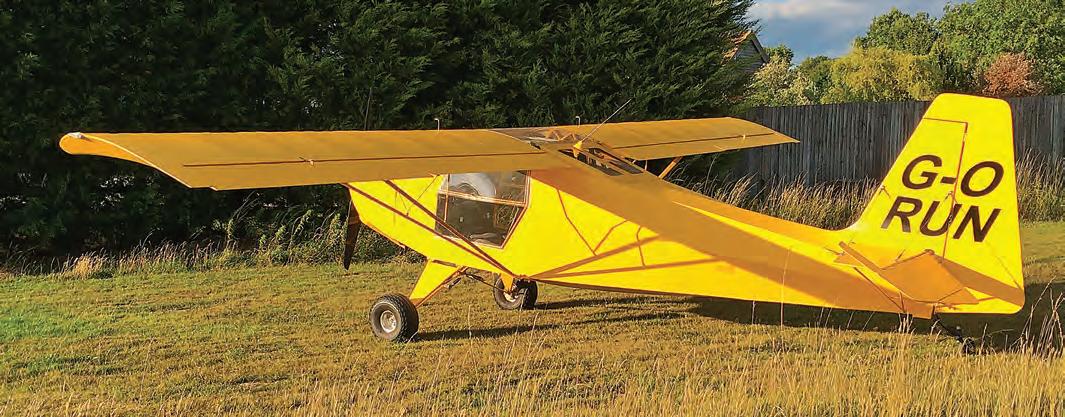
Sherwood Scout. Just for good measure, to improve the performance further, I fitted a Woodcomp inflight adjustable propeller. I operate from a short strip so good take-off performance is important.
I completed the aircraft at the end of 2019, but with waterlogged strips, lockdown and other factors I have only recently been able to fly it. The performance has
If your aircraft has been featured in the New Projects list, please let Project News know of your progress at: projectnews@laa-archive.org.uk
n Van’s RV-7 (LAA 323-15709) 21/7/2020
Mr W Macleod, 60 South Bragar, Isle of Lewis, Scotland, HS2 9DD
n Eurofox 914 (LAA 376-15707) 6/7/2020
Mr J Owen, 44 Waverley Avenue, Appleton, Warrington, WA4 3BN
n Aeroprakt A32 Vixxen (LAA 411-15708) 20/7/2020
If your aircraft has featured recently in the magazine and has subsequently completed its maiden flight, Project News would love to hear from you at: projectnews@laa-archive.org.uk
n G-MHRV Van’s RV-6A (PFA 181A-13422) 7/7/2020
Mr Mark Harris, 27 Tylers Mead, Luton, LU2 7XX
n G-OVEY Van’s RV-7 (LAA 323-15557) 7/7/2020
Mr Matthew Covey, 8 Meadow Close, Witchford, Ely, CB6 2JD
n G-SISX PITTS S-1S (LAA 009-14997) 29/7/2020
Alan & Christopher Millson, 160 Heath Row, Bishop’s Stortford, CM23 5DQ
n G-UKRV Van’s RV-7A (LAA 323-15304) 3/7/2020
Netwasp.Net Ltd., 22 Boswell Gardens, Stevenage, SG1 4SB
matched my expectations and the aircraft is very docile and pleasant to fly. What is not particularly obvious is the cavernous baggage area which will take 35kg. Coupled with that is the fact that the wings can be folded in less than five minutes. All in all, it is a very useful aircraft. As may be apparent from the registration – my other passion is running!
Dr Mason, 58 Church Way, Oxford, OX4 4EF
n Sunderland S-18 (LAA 076-15711) 22/7/2020
Name & Address held by LAA Engineering
n Eurofox (LAA 376-15710) 22/7/2020
Name & Address held by LAA Engineering
n G-BHYI Stampe SV4A (s/n 18) 12/7/2020
Name & Address held by LAA Engineering
n G-BKRK Stampe SV4C (s/n 57) 29/7/2020
Name & Address held by LAA Engineering
n G-BXDI DHC-1 Chipmunk 22 (s/n C1/0312) 15/7/2020
Name & Address held by LAA Engineering
n G-CLDR X’Air Hawk (LAA 340-15604) 2/7/2020
Name & Address held by LAA Engineering
n -KIRB Europa XS (PFA 247-13615) 30/7/2020
Name & Address held by LAA Engineering
n G-MOGN Bristell NG5 Speed Wing (LAA 385-15633) 24/7/2020
Name & Address held by LAA Engineering
n G-OHRA Jabiru J430 (LAA 336-14865) 24/7/2020
Name & Address held by LAA Engineering
n G-VIXY Aeroprakt A32 Vixxen (LAA 411-15683) 22/7/2020
Name & Address held by LAA Engineering

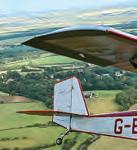


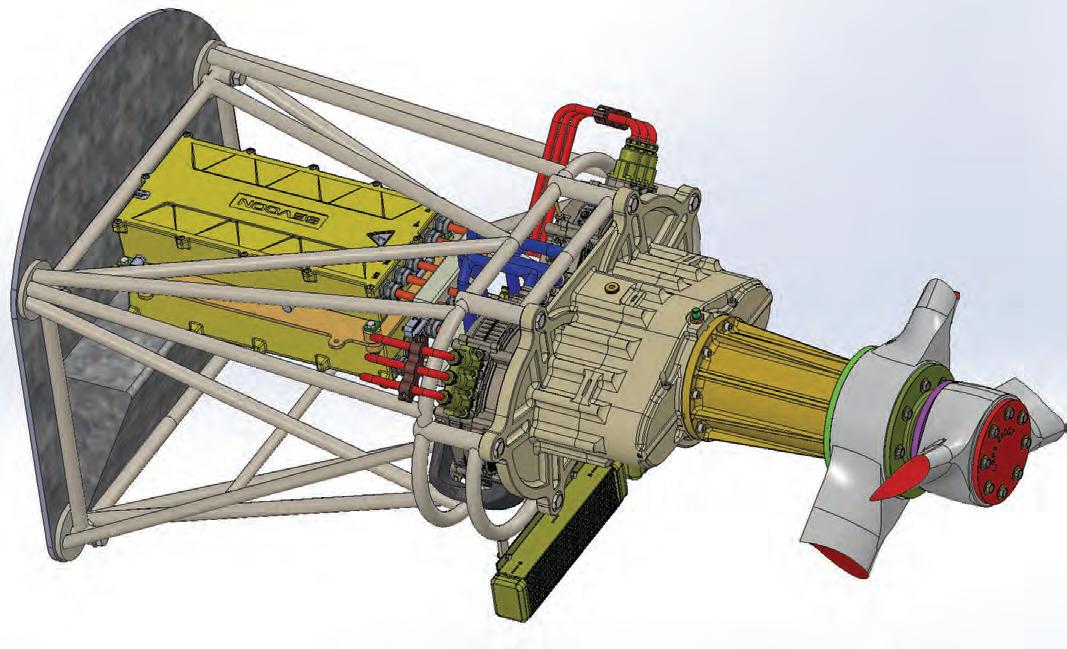
LAA member and electric powerplant pioneer Nick Sills explains the benefits of contra rotating propellers with electric motors…
Over the past five years a small British company, Contra Electric Propulsion Limited, together with several industry leading companies, has developed and ground tested the concept of electrically driven contra rotating (CR) propeller propulsion for light aviation. This article describes the project to date and the numerous benefits of CR over single propellers. It also illustrates the completion of the R&D phase with the manufacture of a 250hp continuous, 400hp max power system for flight testing in Condor Aviation’s Harmon Rocket later this year. The system, known as the CRPS 260 GT, is intended as a direct replacement for combustion engine systems.
The feature in July’s issue of Light Aviation, together with TL 3.28, admirably introduced the basic considerations of using electric propulsion in light aircraft and highlighted some of the benefits and complexities of moving from internal combustion to electric propulsion. However, an important component of the propulsion system, the propeller, was given only brief consideration.
Most aviators understand that it is the propeller that dictates the performance of their aircraft as much, if not more than, the prime mover, but there is little scope for further improving the design and performance of modern combustion-powered propellers. The recent development of high-performance electric traction motors, however,
Above An overview of the CRPS 260GT and mounting frame that will be used to install the system in a Harmon Rocket in place of its existing Lycoming IO-540
offers the opportunity to make drastic improvements in propeller technology. These motors make it possible to design and build simple and affordable contra rotating propulsion systems (CRPS) eminently suited to many types of light aircraft.
The CRPS format offers unique and enormous performance benefits over a single propeller format, even if that single propeller is driven by an electric motor.
Of course, contra rotating propeller systems are not new and were used to upgrade the performance of piston and turboprop military aircraft for decades, but it is the torque curve of modern electric motors that is the game changer here for civil aircraft. Maximum torque is available right from zero rpm to the base speed of the motor and this eliminates the need to use variable pitch propellers.
Although at first glance combustion-powered and electric CR propeller systems might appear similar, there are very significant differences. Combustion driven CR systems normally comprise of two identical variable pitch (VP) propellers, often quite widely spaced due to their complex mechanical construction, and controlled by torque (propeller pitch). In complete contrast, electric driven CR propellers are fixed pitch, closely spaced and the front and rear propellers are substantially different in design. They are designed to absorb the same power at the same rpm. Power (thrust) is controlled directly by propeller speed.
Another major difference is that, unlike combustion engines, electric motors run equally well in either direction,
so can offer reverse thrust in aircraft requiring this facility However, normal fixed pitch propeller aerofoils do not work efficiently running backwards, so for aircraft requiring reverse thrust, we designed our propeller blades with symmetrical aerofoils on their outer diameters. As far as we know this is a unique solution.
Most combustion driven CR systems used a single powerful engine, such as in the Seafire 46/47, Avro Shackleton and Short Sturgeon types, with complex gearboxes to drive the two CR propellers and govern pitch. There were exceptions, such as the Fairey Gannet, which used two independent Mamba gas turbine engines to drive the two propellers.
Electrically driven CR systems will invariably use two independent motors and, as all other components are also duplicated, they will be classified as true ‘twin engine’ systems.
Over the last five years we have designed and tested various fixed pitch contra rotating propeller designs in collaboration with Hercules Propellers Limited and automotive electric powertrain experts, Potenza Technology Limited.
The photographs below illustrate the design and construction of a twin electric motor CRPS 225 assembly built to test the propellers. Together they give 140kW
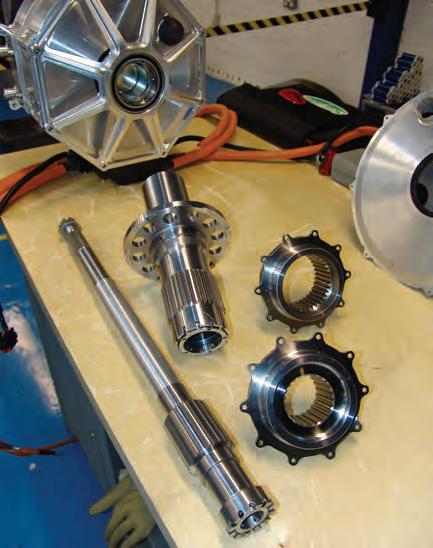

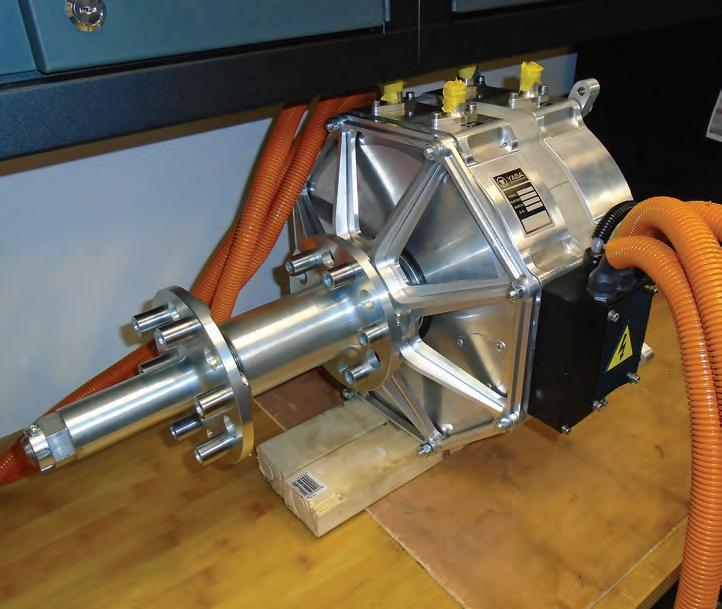
Above The two DD500 Motors bolted together with twin CR propeller hubs.
Left YASA DD500 motors, bearing assemblies, some of the coaxial shaft components and the two splined motor power transmission couplings prior to assembly.
Left below: The complete CRPS 225 assembly together with its cooling system mounted in its purpose designed heavily instrumented test frame.
Right: Propellers are machined to exact parameters from CAD models with the aid of a purpose designed CNC machine and then hand finished.
(180.7hp) continuous and 225kW (301.7hp) peak power at 2100rpm.
The contra rotating propeller pairs were designed to absorb the same power at the same rpm. This meant that each of the pairs were quite different from each other in terms of diameter, pitch, blade area and chord. Algorithms dictating the design of the propellers were generated during an 18-month R&D programme known as Novel Contra Rotating Propellers for Electric Aircraft, assisted by NATEP (National Aerospace Technology Exploitation Programme) funding. The propeller sets were manufactured by Hercules Propellers from laminated beech wood blocks using a ‘loss process’ of manufacture, which ensures each propeller pair was made to exact dimensions, rather than using ‘one size fits all’ mass produced moulded or cast production methods.

In order to test the propeller designs in both static and under simulated take-off conditions, the CRPS unit and test frame were mounted to the rear of an electric vehicle equipped with a 420Vdc, 28kWh capacity battery pack, twin inverters, cooling and performance monitoring systems. During mobile tests the ‘pilot’ had control of the vehicle steering and wheel brakes, the ‘co-pilot’ controlled the motor power, propeller rpm, rotational direction and emergency systems through a handheld control panel.

During static tests the control panel was operated remotely through a 25m umbilical.
The test programme was carried out on Gloucestershire Airport’s runways to examine and record the performance of fixed pitch contra rotating propeller assemblies at different speeds, different power settings, with one or the other propeller at different speeds, in reverse and also to examine failure modes. Data recorded included rpm, torque, thrust, acceleration, power consumption, battery, motor and inverter temperatures, ground and air speed, air temperature and weather conditions. Videos showing some of the tests can be seen on the company’s web site. www.contraelectric.com
In a series of static tests at 135kW (181hp), thrust generated by the electric CR system was measured at 470kg forward and 320kg reverse. This data was compared with that of the Lycoming IO-360 powerplant and VP prop performance in a static Falcomposite Furio aircraft at max power – also 135kW. The aircraft was anchored by a load cell to take the measurements and recorded 310kg forward thrust. Though not a truly scientific test, the result was indicative of the difference in performance of single and CR propeller propulsion at the same power.
An encouraging start to the mobile programme was to record the extremely rapid acceleration of the 1180kg mass vehicle (including pilots) to 63kt in 120m using 135kW power in simulated ‘take-off’ runs. Compared to the same mass piston aircraft (Falcomposite Furio) at the same horsepower with a single VP propeller, this was less than half the distance to achieve Vr of 63kt in 300m with the Furio. Even allowing for differences in profile drag and wheel rolling resistance, this is an undeniably indicative result.
Perhaps the most significant single benefit of the CR format for light aircraft is the total elimination of yaw. The graphs (right) show that each propeller generates significant torque when operated individually but the net torque with both propellers in contra rotation is effectively zero.
Eliminating propeller induced yaw can raise the efficiency of the propulsion system (compared to using the same horsepower with a single propeller) by up to 7% in flight and completely eliminates the four ‘swing’ forces (torque reaction and asymmetric airflow in nose wheel aircraft and asymmetric blade effect and gyroscopic effect in taildraggers) at take-off – greatly improving
handling and safety. Analysis of the ground test data confirmed the performance of the CR propellers to be sufficiently encouraging to warrant flight testing the system so, as an engineering exercise, Condor Aviation and Contra Electric Propulsion converted a Cassutt race aeroplane from piston to electric CR. The CRPS 225 system you see in the test car was installed in the aircraft to see what was possible. The aircraft was exhibited by Airbus at the Dubai Air Show in support of the new Air Race E formula.
Is there an immediate future or requirement for electric propulsion in GA?
As illustrated in the Light Aviation article, there are already a small number of basic electric propulsion systems entering the market suitable for microlights and training aircraft. In addition, companies such as MagniX and Siemens (now
Above Safety was an optimum priority when test driving the electric contra prop unit.
Above right CRPS 225 including power electronics, inverters and cooling in the Cassutt.
Right Electric CR Cassutt race plane at Dubai Air Show.
Below Torque (orange data) generated by the counter clockwise (CCW) and clockwise (CW) rotating propellers (causing yaw) and the two contra rotating propellers together nullifying torque (no yaw).

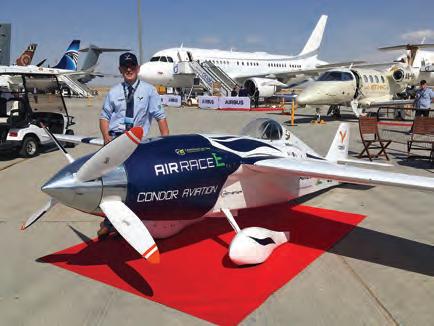

RR) have developed motors up to 500kW (670hp) for single propeller commercial applications but their high cost and the marginal performance benefit over conventional combustion systems inhibits their use in most private light aircraft. At present the range of a battery powered electric system, compared to a combustion system of the same gross weight, is about 1/6th – not ideal for touring – but there are significant benefits in far lower operating costs, emission free flight and reduced noise.
Over the years, a considerable number of companies have approached CEP Ltd asking when an electric contra rotating propulsion system was likely to be available to test in their specialised types of aircraft. Several Alaskan float and ski-plane operators have stated that upgrading their piston powered aircraft with a similar power electric CR system which offers yaw free thrust, can go to full power almost instantly (giving STOL performance) and provides full reverse thrust on demand, would constitute the ‘Holy Grail’ of propulsion systems to them in their operational environment.
Modern sky divers using wing suits and other aerodynamic devices, crave to jump from ever higher altitudes to extend freefall time. Existing piston carriers struggle above 10,000ft and turboprop carriers are very expensive to operate. This sport’s dream machine would be C182 type aircraft with a rapid ascent (sub 10 minutes) to 15,000ft, very low operating costs and rapid turn-around times (recharge/battery swap) allowing 10 flights a day or more.
High performance aerobatic aircraft fitted with electric contra rotating propulsion could undertake completely new aerobatic manoeuvres, impossible with single propeller systems. A factor not lost on one particular high-end designer who commented that he could already see a new sports aircraft design emerging.
These three sectors represent a fleet of some 16,000 aircraft worldwide and have provided the market incentive for CEP Ltd., to proceed through design to manufacturing the first pre-production CR system. In the majority of cases, operators say they are willing to sacrifice range and endurance for extreme performance – a 20 to 30-minute endurance is more than adequate in many applications.
The first systems will therefore use pure battery energy sources, rather than more complex hybrid solutions. Most operators have said that a 200kW (250hp) continuous power rating would be sufficient for their needs with 75-100kW (100-125hp) nominal at cruise. However, a feature of some electric motors is that they can operate for short durations at significantly higher powers than their continuous rating. Two YASA P400 RHC motors capable of providing a combined 200kW (250hp) continuously, providing 260kW (325hp) for 10 minutes and 320kW (400hp) for one minute, were therefore chosen to power the CRPS 260 GT unit.
In the non-aviation sector, there are some 8,000 sports, utility, emergency services and military air boats operating in the USA, many using combustion powered contra rotating propeller propulsion systems. Increasingly, operators are seeking new quiet and pollution free systems to meet evolving environmental and noise reduction legislation. For these applications, CEP Ltd. are considering upscaling a CRPS to 1mW (1341hp).
The benefits of electric CR compared to single prop combustion systems

■ Twin ‘engine’ safety and classification.
■ Yaw free thrust.
■ Axial loading only to airframe/firewall (negligible radial loading).
■ Rapid full power response on demand.
■ Full reverse thrust (with reverse capable prop set)
■ Increased air speed. Up to 0.1 Mach (75mph) above single prop max speed).
■ Smaller propeller disc diameter at same power.
■ Simple mechanical construction.
■ No exhaust or pollution.
■ Virtually silent motor operation.
■ High energy efficiency.
■ No engine warming, shock cooling or spool up time.
■ Recharge using ground power, wind or solar sources.
■ No change in power output at sea level or high altitude.
■ No liquid fuel.
■ Offers aerobatic a/c unique manoeuvring capabilities.
■ Negligible ‘engine’ vibration.
■ Propeller noise reduction by desynchronising propeller rpm.
■ Very low maintenance.
■ TBO extended beyond 5,000 hours.
■ No weight change during flight.
■ Pilots do not require ‘twin engine’ licence rating to operate coaxial systems.
YASA Motors Ltd., which manufactured the motors used to develop the CRPS 225 propeller test system, have unfortunately discontinued its production. A survey of motors worldwide shows no other motor is commercially available with a similar architecture to YASA Motors’ DD500 series. This motor had a large central clear annulus of 110mm suitable for installing a central coaxial shaft assembly and drive splines, ideal for producing a simple CR system by bolting two motors in line and operating them in opposite directions.
All future CRPS designs will use a power transfer box to house the coaxial shaft assembly and be driven
by parallel twin electric motors running in opposite directions. This arrangement does have the great advantage that all propeller and aerodynamic loads can be carried by the power transfer box casing, so that the motors play no part in the structural assembly. This will make the certification process more straightforward – a number of different off-the-shelf automotive developed and extensively tested motors can therefore be specified.
The power transfer box houses the coaxial shaft assembly, power transmission gears and shafts, thrust and roller bearings, oil and cooling systems and is stressed to +/-10G. Two YASA P400 RHC electric traction motors, each rated at 100kW (125hp) continuous and 160kW (214hp) peak running at up to 7,000 rpm are mounted to the rear of the power transfer box. Two contra rotating fixed pitch propellers (cut down) are shown to the front.
Note : NASA too is relying on the efficiency of contra props on its autonomous helicopter Ingenuity for the challenging atmosphere on Mars. When the Perseverance Rover mission lands there on 18 February 2021, the 1.2m, 1.8kg Ingenuity will be the first flying vehicle ever to operate on another world.
The UK Government’s ATI Innovation Funding Service claims to be highly supportive of SME (small and medium sized industry) proposed aerospace development projects. A recent application for assistance with the development of the electric CRPS 260 GT propulsion system (aimed at introducing affordable fixed pitch contra rotating propeller technology into the UK light aviation and GA sector) was refused on a financial technicality and scored zero points out of 70 for application content. Much of the application content is repeated in this article and I would invite comment from LAA members who have attempted to acquire grant funding. nick.sills@contraelectric.com
Conversations with many SMEs about their success in gaining grant funding for light aviation projects, makes
depressing reading. I would urge the LAA to consult with its members and perhaps approach the ATI to relax the competition rules that blatantly discriminate against SME’s.
Without ATI assistance, manufacturing the CRPS 260 GT system in the UK is not financially attractive. Production has therefore been moved overseas, which is regrettable for the UK light aviation manufacturing sector.
An early supporter of Electric CR, Ian Whittle, did warn me that his father’s experience was that UK Government Aviation Authorities often smothered developments by small companies rather than support them. It seems little has changed! ■
Dimensions: The complete assembly with twin motors, propellers and cooling services will weigh 125kg and principal dimensions of 950mm total length, 725mm width 400mm depth.
Power transmission unit: Designed by John Lawson, one of few experts in this field, the unit takes all the aerodynamic loads and is designed to allow independent operation of the two motors and propellers. Propellers: Matched contra rotating fixed pitch pair operating at up to 2,700rpm. Diameter 1800mm front, 1740mm rear.
Electrical system: Two liquid cooled Sevcon Gen 4 size 10 inverters/controllers drive the two motors and will be powered by two 22kWh X 800Vdc battery packs with 12C discharge capability and full battery management systems (BMS).
Performance: It is expected that the Harmon Rocket test aircraft will have a super STOL performance allowing take-off (nil wind) within 100m, initial climb rate of 6,000ft/min and top speed exceeding 220kt. Service ceiling would exceed that requiring oxygen or pressurisation.
NOTE. A single fixed pitch propeller offers aircraft a relatively narrow speed range efficiently, but a fixed pitch CR pair offers a considerably wider speed efficiency range. In most applications an electric CR system matched to a specific aircraft will out-perform a same horsepower combustion engine even with a VP prop at both slow (take-off and climb) and high-speed cruise.

Left A quarter scale engineering model of the CRPS 260 GT unit. The power transfer box is fitted with transparent casings to show the internal components.
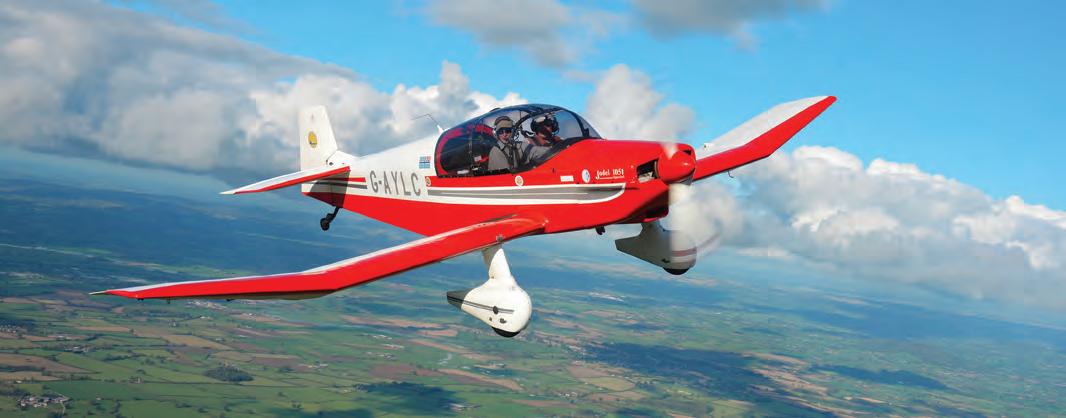
One of Europe‘s most influential aircraft designers and manufacturers, Pierre Robin, passed away on 5 August, aged 93. Inspired by Henri Mignet, at 19 years of age Robin built a Pou-du-Ciel (Flying Flea) with two friends, and although at the time he did not have a flying licence, he went on to learn on gliders at Tours the following year, later becoming an instructor.
Having also become a light aircraft instructor at Challes-les-Eaux, in 1952 he started the build of his first Jodel, a D9 Bébé, using his skills as a carpentry teacher. He went on to build a D112 and, having relocated to Dijon-Longvic as instructor and chief pilot, in 1954 he met Jean Delemontez, who asked him if he would like to flight test Jodels for him.
Robin was keen to develop a 2 + 2 Jodel, as indeed was Delemontez who, having completed and flown the first Jodel D9 in 1948, had commenced work on his next design, the D10, just such a variant.
However, it had to be put on the back burner when the French Government launched a competition for a two-seat club trainer, for which he designed the D11. It famously did not win the competition, that honour going to the SIPA S90 of Yves Gardan, but it became by far the most successful of the designs entered.
Robin and Delemontez came to an agreement to develop the D10 and thus began the DR collaboration that continued for 30 years. This first aircraft, F-PIER, flew in early 1957 and in that same year they launched Centre Est Aéronautique at what was then Dijon-Val Suzon aerodrome, now Dijon Darois. A small initial batch of what was launched as the DR100 were powered by the

C90 and from then on the type used the O-200, the DR105 featuring an airbrake. Further improvements led to the DR1050 and the DR1051 (fitted with the French built Potez 4E20 105hp engine).
Robin believed that racing improved the breed and competed in the Sicily Air Races in the early 1960s with great success, later variants of the DR105/51 Ambassadeurs becoming the Sicile and the Sicile Record.
The type was also built by Societé Aeronautiqué Normande at Bernay as CEA could not keep up with demand. In all over 790 of these DR100 types were produced before the company introduced the DR200 series in 1964. Of particular relevance to the LAA of course is that the DR100/105 series became an LAA Permit type in 2008.
CEA became Avions Pierre Robin in 1970 and remained as such until 1988, when the company was acquired by Apex Aircraft, who also owned Avions Mudry, who built the CAP (Constructions Aéronautiques Parisiennes) aircraft, most notably the CAP10. By this time of course, Robin was building the DR400 series, the ubiquitous French aeroclub
training machine. He had also ventured into metal aircraft, having engaged another designer who is a well known part to the homebuilt aircraft scene, Swiss, Chris Heinz, who established Zenair.
The first ‘metal‘ prototype, the HR100/80, first flew in 1969 – it actually used the wooden fuselage of a DR253 Regent with a metal cantilever wing powered by a 180hp Lycoming O-360. A range of all metal aircraft was then developed, from aerobatic trainers to four seat retractable tourers.
A particularly interesting development in the early 1980s was the ATL (Avion Très Léger – very light aeroplane), which the company designed to meet a competition requirement for a new, low cost trainer for French flying clubs, pretty much a return to the competition three decades earlier that brought the Jodel D11 onto the recreational flying scene. The ATL won the competition with its ‘tadpole‘ style composite fuselage with high visibility bubble canopy, all metal V-tail, and wooden wing. Powered by a JPX 4XT single ignition converted VW engine producing 65hp (48kW) it was something of a look at future design trends, had the Rotax 912 been around, it might have enjoyed more success but with a history of engine problems, only 132 were built before production ceased – the final handful having a much improved dual ignition 70hp Limbach engine.
It is, though, for his collaboration with Jean Delemontez and the resulting developments of the Jodel
that Pierre Robin will be remembered. The wooden cranked wing remains in production 82 years after that first D9 flew on 22 January 1948 in the form of the DR400/500, still being built in Dijon, and still by far the most popular aircraft used by French flying clubs, and loved by many private owners. ■
In the absence of a 2020 LAA Rally, Nigel Hitchman and Brian Hope take a trip down memory lane to recall those that have gone before…
As this issue of Light Aviation drops onto your doormat it is the time of the year when we would usually be about to enjoy the Association’s annual Rally at Sywell. Unfortunately, as we all know, it hasn’t been possible to run the event this year, so we have decided to take a look back at just a handful of the many highlights from a selection of Rallies past.
The very first Association Rally was planned for 1 June 1956 at Shoreham, but was washed out due to bad weather. A better start was made the following year at Sywell on 14 September, from where it moved around for several years before a sustained term at Sywell from 1969
Below The final Cranfield Rally in 2002 saw the first UK appearance of the Alpi Pioneer P300. I-6445 was one of a group of six that flew in from Italy.
until 1978. It then went to Leicester for three years before a long-term residency at Cranfield from 1982-1990. A three year stint at Wroughton then saw a return to Cranfield from 1994-2002, with the 2001 Rally having been cancelled due to the Foot and Mouth outbreak. It then went to Kemble for four years, the final event of what are regarded as the ‘old style’ Rallies taking place in 2006.
The current series of Rallies at Sywell started in 2009 under a new business model and, until COVID-19 put paid to this year’s event, it had been growing year on year. Next year will be the Association’s 75th Anniversary, and we are planning for a bumper celebration Rally on 3/4/5 September – and we hope to see you all again then.




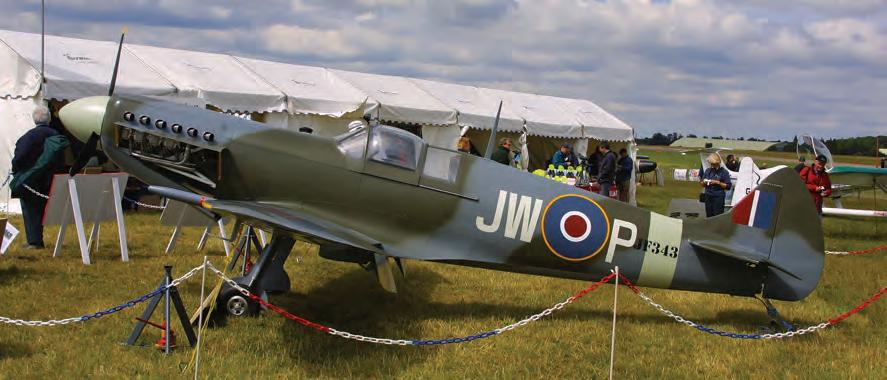
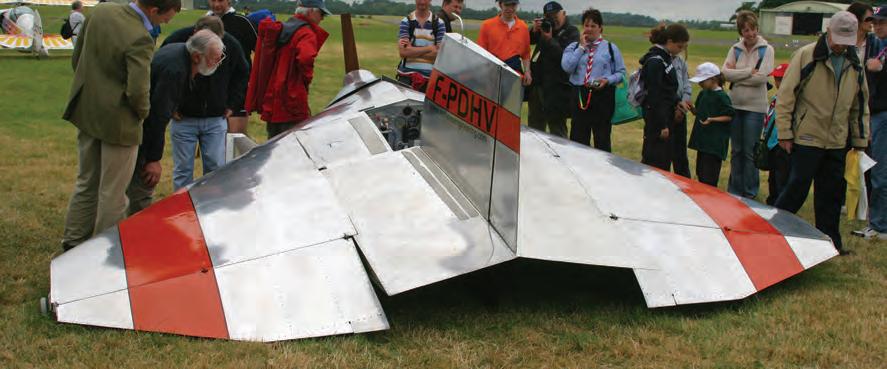
Left At Kemble in 2003, OK-PRO L.200 Morava, a vintage twin from Czech Republic, was the highlight for many enthusiasts.
Left Homebuilt gyroplanes were also more prevalent in the Cranfield days, G-YROY being a Montgomerie Merlin among a good line-up of gyroplanes.
Left It was 2004 that saw the first UK-built Supermarine MK.26 Spitfire, G-CCZP/ JF343, built by John Pearson. It was exported to the US in 2012.
Left The following year Belgium’s Bart Verhees caused a sensation with his radical Verhees Delta D1 F-PDHV. Bart has been a regular at the Rally, more recently bringing his two-place Delta D2.


Above Somewhat radical was Don Foreman’s Rutan Defiant G-OTWO, the sole example built in the UK, which first flew in the late 1980s. Don brought the engines back from the US as ‘hand luggage’ on Freddie Laker’s Skytrain and before an airbrake was fitted, he used to cut the rear engine on the approach or it floated forever! It was sold to Germany in 2012 and later transferred to the American register.
Left Kemble 2006 was the 60th Anniversary event, and a rare one-off UK design that hadn’t flown since 1990 made an appearance. Coates Swalesong II G-AYDV, designed and built by Jim Coates in the 1970s, was restored to fly by Jim’s friends following his death and was flown to the Rally by Neil Plumb. It is now with the Real Aeroplane Company at Breighton, along with Swalesong I, G-AMAW, Jim’s modified Luton Minor and one of the first aircraft to be approved under the Association’s Permit to Fly scheme.
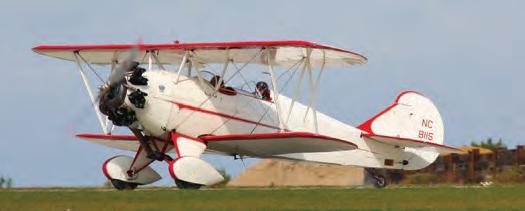
Above We called the 2009 return to Sywell the ‘Sywell Revival’, but its future depended on the success of that first event. Thanks to members’ support and aircraft like Travel Air D4000 Speedwing, NC8115, it was. This famous aircraft that was put into storage during WWII but didn’t emerge until Nick Rezich restored it in the 1970s and the Rezich brothers, barnstormers and airshow pilots from the Chicago area, campaigned it across the country. Sold in Canada, Ron Souch and Richard Seeley bought it in the late 2000s and shipped it to England, with the Sywell Revival being one of the first events it attended. It has subsequently been out of the air for a few years but flew again recently after much work by Hants Light Plane services, Chilbolton.


Left G-ICBM, a Stoddard Hamilton Glasair III was in attendance in 2010. It was built by Glenn Waters and is powered by an Allison C250-B17B turbine. Glenn’s previous aircraft was also a hot ship, Berkut G-REDX, and was also present.
Left British amphibians are rare but this lovely Pereira Osprey 2, G-CCCW, built by David Southward, also arrived in 2010, flown from Kirkbride. One other Osprey, G-BEPB, appeared at Cranfield in the 1980s, but hasn’t flown for a long time.

IO-390
as seen here. Seating two in tandem, it was slated for further development with retractable landing
and armament, rather than the original ideas to sell it as a homebuilt kit. However, it hasn’t had a CAA Permit to Fly since 2016 and nothing more has been heard.
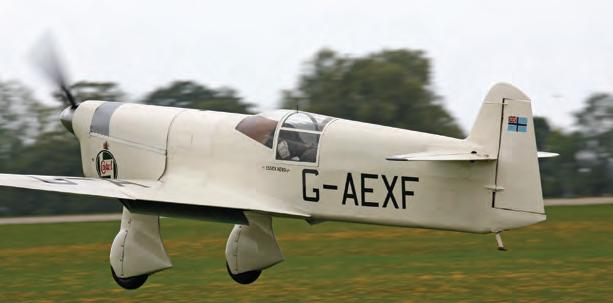
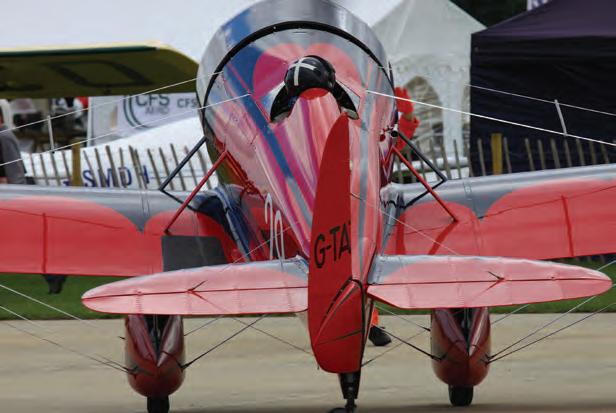
Left A real highlight in 2011 was G-AEXF, the Percival Mew Gull, then operated by the Real Aeroplane Company at Breighton. This is Alex Henshaw’s Mew Gull in which he made his incredible flight from Gravesend to Cape Town and back in a total elapsed time of a little over four days in 1939. The Mew Gull was bought by the Shuttleworth Collection in 2013, where it remains and is regularly displayed.

Above F-PMOZ, a ¾ scale replica de Havilland Mosquito was a fantastic project by Michel Bogaert and friends who built their dream over 17 years and more than 30,000 hours. Of wooden construction, it was powered by two 300hp Lycoming engines from a Cessna 411 and first flight at Fontenay Le Comte was in April 2011. The trip to the 2013 Rally was flown by famous French airshow pilot Jack Krine, one-time leader of the Patrouille de France and current pilot of many historic aircraft at La Ferte Alais and elsewhere, including leading a jet aerobatic team of Fouga Magisters.
A really fabulous aircraft, which from many angles, especially in flight, looks very much like a real Mosquito, although the cockpit is a little on the large side. For four years the aircraft thrilled the crowds at many airshows and fly-ins in France, before an unfortunate landing accident at home base broke the back of the aircraft, necessitating considerable repairs. The repairs were progressing back at Fontenay Le Comte, but the website doesn’t seem to have been updated since 2018, so it is difficult to know its current condition. www.bogaert. jimdofree.com



With the restrictions lifting, the vacillation had to stop and the all-important question needed answering – ‘to fly or not to fly’? For me, that didn’t mean a trip around the block or an hour or so from base, but going somewhere with a little je ne sais quoi
Most of the EU was showing a lower incidence of the coronavirus than the UK, so European flying could hopefully resume, but was it more sensible to stay at home? Of course, as I see it, you don’t want to catch COVID-19 or be responsible for facilitating its spread, but neither do you want to live like reclusive hermits for what may be an indeterminate period. The advice from No.10, as far as I could determine, wasn’t of much help and appeared capricious to say the least, stay at home, go to work, go to the pub, don’t visit the beach, and here’s a ‘tenner’ to go out and eat
Much as I’m sure that it’s possible, just possible, that Boris and his advisors know what’s best for the rest of us, for me the question of whether or not to fly to mainland Europe needed a touch more depth, a little more knowledge and at least the kind of clarity that could only be given by those with medical expertise.
Just before the lockdown I had a trip planned to Friedrichshafen with Liverpool-based forensic pathologist and author Dick Shepherd, on a very typical confidencebuilding mission. With plans thwarted by the pandemic, the idea was shelved until things sufficiently improved. After
Main Final approach across Lac du Bourget for Chambéry for Runway 18. It’s one way on – and one way out the big boys.
Below Dick Shepherd and his C172. The trip was a confidence booster for him, wrapped up with a visit to his brother Bob.
several discussions, the ‘doctor’s advice’ appeared to be that by using masks, socially distancing, and armed with a litre or two of hand sanitiser, we should be able to manage a few days away without spreading or contracting the disease.
Having a brother living in Chambéry, it was on Dick’s ‘bucket list’ to fly into the airport and take brother Bob for a flight over Lac du Bourget, nestled in the valley below the mountain ranges. Known locally as Lac Gris, the approach into the airport is quite spectacular, with the massive lake below, the Chaîne de l’Épine of the Jura to the west, Mont Granier and the Chartreuse Mountains to the south and the Massif des Bauges (Pre-Alps) lying to the east. In the benign conditions, it was as stunning as it was aweinspiring, but also easy to see how the terrain would affect things in anything but such conditions.
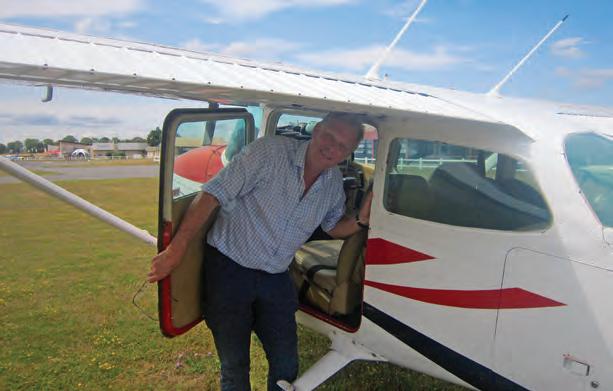
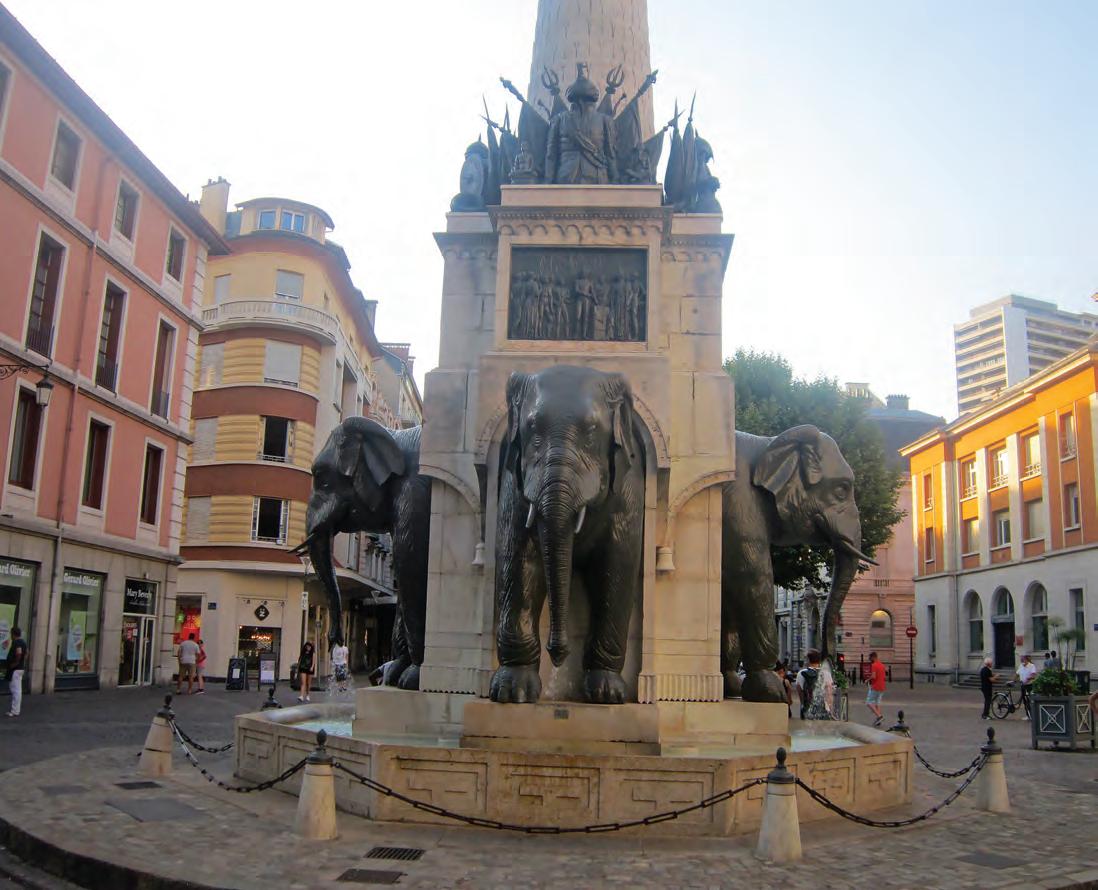
Quite understandably, commercial pilots require a specific check-out before being let loose from the airport, as for them it’s one of those places that is one way ‘in’ and one way ‘out’ regardless of the wind.
Just by chance, the EFLEVA & EAS (Swiss LAA) Fly-in at Langenthal was taking place the same weekend and, at only an hour away, it should give added interest, not just for us but for so many fellow Brits who had been looking for somewhere to go.
As Sian and I had been before, I knew the format, so it shouldn’t be too hard to socially distance and take reasonable precautions. www.experimental.ch/events/
The email to those on the fly-out list produced responses from ‘thanks, but we’d rather wait until next year’ to ‘yes please’ before the 2020 season became an evanescent memory.
With a strong British contingent registered, considerably up from the two of us who had attended last time, a closer inspection of the details rang alarm bells for Dick’s Cessna 172. The runway was less than 600 metres long and although it didn’t present a problem for most LAA types, with forecast winds of less than five knots, temperatures of 34˚+C and a runway elevation of 1,575ft, it really didn’t take much calculating. It was hot, high with no wind, and for the aircraft, a short runway. The density altitude of 4,000ft would make the landing marginal, although those ‘Fowler’ flaps would probably get us in, but getting the heavy old bird back out again really required more horses or more room.
Above This Elephant monument and fountain commemorates General de Boigne, a native and generous benefactor of the town, and was built in 1838. The limestone column rises to over 17m with the general’s statue aloft.
Although disappointed, I was more concerned about the other aircraft planning to make the trip, especially those on their early forays. Arrangements had been made to meet pilots at Lydd, Troyes and Annecy, with others making their own way on different days and by different routes. The solution was to stick to the plan as far as Annecy and then visit Chambéry with its 2,000 metre runway, as the others made the short hop into Switzerland.
Over the years Troyes has been a favourite customs stop, simply requiring four hours’ notice with never an official around. Nowadays… You’ll have to excuse me while I have a short rant… Since the events of June 2016 (the ‘B’ word), things have been changing year on year. Not only is more notice required, but the clearance is only acceptable when presented on a specific form. I guess the ink just disappears or self-destructs like the tapes in Mission Impossible if the same information is not in their neat little boxes. The issue is that the program used is incompatible with the iPads and tablets most pilots use, and not even totally straightforward on a desktop. This is not a new phenomena of course, similar issues plagued the introduction of AFPEx and online GAR forms here in the UK.
There are ways to circumnavigate the issues through third party programs, but don’t all authorities have some obligation to make it as easy as possible for us to comply with regulations, especially when falling foul of them can carry high penalties?
We had difficulties that took a good 20 minutes to resolve, as times on the form are meant to be local as opposed to UTC and they wanted evidence that we had submitted everything in time.
As a tip, if you struggle with it, print out the blank form at home, fill it in by hand, take a photo and send it as an attachment with a normal email, taking the copy of the original with you. To add to the confusion, the correct address is not the one on the form, but contact codt-metz@douane.finances. gouv.fr. (Tues-Fri before 1600 the previous day and Sat-Mon before 1600 Friday). For anyone with an 8-track cassette player, a Betamax video recorder or a fax machine, they offer a fax service to make our lives easier (+33 3 87 36 00 84), but I cannot guarantee the number of course…
By the way, after raising the same issue with Calais Customs a few days later (ccoc-calais@douane.finances.
gouv.fr), they said an email with the same information would suffice, which – give me strength – was how the whole anfractuous process started with Troyes in the first place!
I never could, and still can’t, see why GA can’t simply list basic info like passport number and date of birth in ‘Other Information’ on the flight plan, which would confirm exactly who is on board to those who need to know.
Six of us went out to dinner in the centre of Troyes’ old town
Below The summertime temperatures in the region encourage eating al fresco –good for reducing the spread of COVID-19, but there was often little by way of sanitised
bars and cafés housed in the nostalgically attractive 16th century buildings. It had been five months since I’d last been out for a meal anywhere, but sitting on the outside terrace of a French restaurant enjoying a particularly good house wine on a balmy summer’s evening, acted as a soothing tonic and finally answered that nagging question of ‘acceptable risk’.
After the next evening in Annecy, the others made their way to the fly-in while Dick and I hopped across to Chambéry, better known to many as a winter sports hub. The resorts of Chamonix (just below Mont Blanc), Courchevel, Meribel and many others are within a couple of hours.
In the UK, PPR is considered sacrosanct, although in France it is rarely expected but, as the airport can get very busy and is used by the major airlines, we rang to check only to be told that the requirement only exists in the winter season. This is definitely a ‘big boys with long-trousers’ airfield, but thankfully without the officialdom, and while we were there, the helicopters, parachutists and GA seemed to coexist seamlessly. It was no more difficult to fly into than Lydd or Calais on a quiet day. In the typical French style, while at the hold and waiting for take-off, we were asked to hold position while a fighter jet, whose pilot just happened to know the controller, did a touch-and-go.
On landing, we were directed to the business centre and met by a minibus, onto which we unloaded everything before taking Bob flying, as we still had a density altitude of


course, but the climb performance would suffer in the thinner, hotter and less dense air. It turned out that Bob was a scientist and despite no previous aeronautical experience he had an almost instant grasp of anything remotely technical, from air density and leaning, to creep-marks on the tyres. Both Dick and his brother turned out to be great guys and I was genuinely in the company of a couple of clever blokes, who did well at the three ‘R’s as kids and must have been in bed by 6pm having eaten all their greens.
The total cost for our landing, local flight and overnight parking, including the minibus service from the friendly woman in the business centre, came to a total of €22, although I wouldn’t like to guess what it might cost in the busy winter months.
With a population of a little less than 60,000, Chambéry was made the historic capital of the Savoy region 1295 by Amadeus V, Count of Savoy, and remained so until 1563 when that honour was granted to Turin by Duke Emmanuel Philibert when France began flexing her muscles. The Royal dynasty of the House of Savoy began in 1003 and became a powerhouse ruling Sicily, Sardinia, Spain and The Kingdom of Italy, which eventually led to its unification in 1861 through its Savoy-Carignano branch.
During the summer months, there is an abundance of accommodation available from around £45 per night, so I wouldn’t panic about needing to pre-book. Going through the ski season would be a different matter and a different price altogether.
Ibis budget Chambéry, about a 20-minute walk from the centre of town, at around £55 per night is basic, clean and with air con. (Centre-Ville 391 Avenue Alsace Lorraine, 73000. Tel: +33 892 68 31 73).
The three-star Kyriad Chambéry Centre – Hôtel et

Top Rue d’Italie, typical of the charm retained in the old town – not a red pavé brick anywhere to be seen.
Above The narrow walkways of an old French town, often leading to charming little squares and hideaways.
Résidence, priced around £75 per night, is a 10-minute walk from the old town. Be careful as there are two Kyriads, the other is cheaper, but a long walk away. (371 rue de la République, 73000).
Petit Hôtel Confidentiel is a five-star hotel luxury at the posh end of the town centre, with discounted rooms for £225 per night. They also offer a pick-up service from the airport (extra charge). (10 rue de la Trésorerie, 73000).
Chambéry has quite a rich food culture, where the mélange generated by the opulence of the Court of Savoie and the peasant’s agrarian lifestyle is reflected in the cuisine. Local dishes like crozets and ravioli originate from Turin and others, like Diots de Savoie, a local sausage, are cured or served in stews along with simple boiled potatoes and Dijon mustard. The region is

also well known for its winemaking, try one of the Altesse, Jacquère or Chasselas Chardonnays, accompanied by the locally made Tomme da Savoie or Beaufort cheese, which is very similar to Gruyère.
If you go to the market, lookout for the Savoy cake, a recipe created in1358. For the locals it is cut with an ‘Opinel’ (a folding knife) invented in Chambéry in the late 19th century.
Le Vivaldi. Where the menu ranges from simple pizzas to full three-course meals at a reasonable price. 32 rue Croix D’Or, 73000. Tel: +33 4 79 33 58 42. www.restaurant-bistrot-italien.fr/
Les Gourmands Disent. One of the nicest restaurants with a €33 set menu. 43 rue de la République, 73000 +33 4 79 33 57 05. www.restaurant-les-gourmandsdisent.com/FR/
Le Savoyard. Really good value at lunchtime with three-course set menus for €17 but much more expensive in the evening. 35 Place Monge, 73000. Tel: +33 4 79 33 36 55 www.restaurant-le-savoyard.com/
Both Italian and French influences are reflected in the architecture, along with a remarkable amount of Trompe-l’œil (three-dimensional artistic illusion).
A wander around the old town, with its labyrinth of allées (passages) that lead to secret courtyards, suggest an air of mystery and intrigue. Exploring them by daylight was one thing, but our guided tour was made even more atmospheric and almost clandestine approaching midnight by ‘Bob the brother’.
Château des Ducs de Savoie dominates the old town and, as the name suggests, was home to the Dukes de Savoie. Apart from exploring the castle, if you’re around on the first and third Saturday of each month, at 1730 a concert is held within its grounds. 30 Place du Château. Tel: +33 4 79 33 42 47 https://tinyurl.com/yxov92ht
Museum of Charmettes was for a time the house of the Genevan composer, writer and philosopher, Jean-Jacques Rousseau. Aspects of his political philosophy were influential throughout the Age of Enlightenment, the French Revolution and even of some modern political thinking. (https://tinyurl.com/y4n4wdfl) La Fontaine des Elephants. Erected in 1838 in honour of General de Boigne, it is probably the monument most associated with the town. Benoît de Boigne served in
Above Parc de Verney provides a lovely respite from the heat of the day.
the military and made both his name and fortune in the service of Mahadaji Sindhia of Gwalior, the ruler of the Maratha Empire in Central India. On his eventual return to the town of his birth, his charitable work earned him the posthumous position on top of the monument. 10 Place des Éléphants. Tel: +33 4 79 33 42 47. https:// tinyurl.com/y6xc5qeh
The Cathedral and a couple of other museums may also be of interest. Given time and the use of a car, the drive to Mont Granier is quite spectacular, or a tour of the many places of interest around the lake. For those that like walking, there are lots of opportunities and of course, in the season there’s the skiing.
Whether you decide to go anywhere or not in the current climate is a personal choice, and I appreciate that people with both points of view have valid reasons for feeling strongly one way or the other. As far as I see it, doing things as we did before is not sensible. Unfortunately, not long after our return to the UK, it became necessary to self-quarantine for 14 days if you had visited France and, at the time of writing, any possible French retaliatory action was unknown.
Whether travelling in the UK or abroad you have to be prepared to take responsibility and exercise precaution for your own safety rather than rely on others.
Our experience was that the waiters in the bars and cafés handled everything from bread, glasses and money without any sanitising in between. In one hotel breakfast was buffet style, which we chose to pass on even though we had paid because everyone helped themselves as if there was no problem. I selfquarantined on my return, half expecting symptoms, which thankfully never came.
Anyway, whatever your take on the current pandemic, in the immortal words of Sgt. Phillip Esterhaus in Hill Street Blues – let’s be careful out there! ■
If you need a bit of confidence building, want to cross the Channel, or help with touring in general, Martin is only too pleased to help.
Email: lightaircrafttraining@yahoo.com
Tel: 07598 880 178 or text
www.lightaircrafttraining.co.uk
A browse through the ‘favourite destinations’ of the website should provide inspiration for places to visit. The ‘touring’ pages contain a useful amount of info with regards to formalities, radio procedures, flight plans etc. for those that want to go it alone.
For a little amusement on bad weather days, try the ‘bit of fun’ section on the ‘contact’ page.

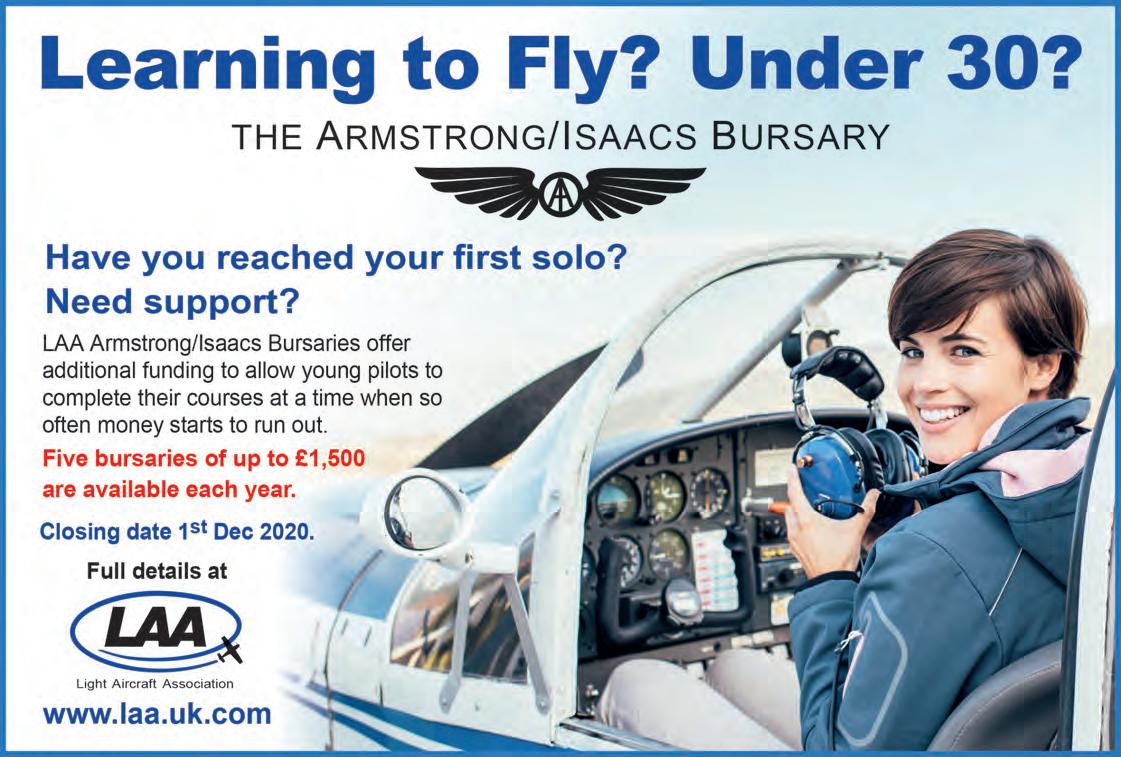
For October we have four FREE landing offers which I hope will help you to enjoy what is left of our very truncated 2020 flying season. If the weather is kind please get out and enjoy whatever opportunities present themselves, winter will all too soon be upon us.
Free Landing For October 2020
Bodmin Airfield 01208-821419
Operated by the Cornwall Flying Club, Bodmin is a very friendly airfield, 5nm NE of Bodmin town. PPR essential. The Windsock Café is open seven days a week and taxis can be arranged to take you to the Bodmin and Wenford Railway, for a ride through the Cornwall countryside. Nearby there’s
Bodmin in Cornwall, Breighton in the East Riding of Yorkshire, Oaksey Park in Wilshire and Sittles Farm in Staffordshire, have kindly provided us with great destinations. Please take note of PPR requirements and in some cases restricted use – and COVID-19 is still impacting on some operations.
Lanhydrock, a National Trust property, the Eden Project at St. Austell, and Padstow (Rick Stein seafood restaurants). There are two runways and avgas is available. Be careful of turbulence and downdraughts. Radio 120.330
www.cornwallflyingclub.com
Free Landing October 2020
Breighton Aerodrome 01757-289065
Breighton is located 5.5 miles north-east of Selby, and is home to The Real Aeroplane Company, which has a great collection of historic and varied aircraft on the airfield. Please PPR – non radio aircraft welcome – and join for the grass runway on the live side for a 700ft QFE Southern circuit as there is often
aerobatic activity which takes place on the Northern side of the runway centreline. No overhead joins please. Avgas and JET A1 fuel on-site – self-service. Restaurant with food and drink on site. Radio is 129.805. www.realaero.com
Free Landing – Monday to Saturday October 2020
Oaksey Park, Wiltshire 01666-577130
Oaksey Park is one of England’s best-kept airfields. Only use the main runway, 04/22 unless told otherwise. The airfield is approx 3nm SE of Kemble, just outside the Kemble ATZ; so there is no dead side to the circuit pattern which is shown in the charts section of the airfield website. Because of local noise sensitive areas,
no circuit flying is permitted. Departures from Runways 04 and 22 should make a 15˚ right turn as soon as can be safely done. Avgas and JET A1 on-site. Tea and coffee available, so take a sandwich, a car service is available to get to the local pub. No Sunday visits. Radio 132.230, not always manned. www.oakseyparkairfield.co.uk
Free Landing October 2020 Weekends Only
Sittles Farm, Lichfield, Staffs
Sittles Farm is located in a lovely area of Staffordshire countryside near Lichfield. PPR via the mobile numbers shown below please and take a look at the airfield website. Weekends only please when local flyers will be around. No fuel. Runway 09/27 preferred. Look out for nearby power lines. Phone Richard on 07773
777160 or John 07786 084194. Sittles Radio is on 129.830 www.sittlesflyers.com

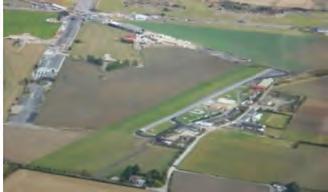
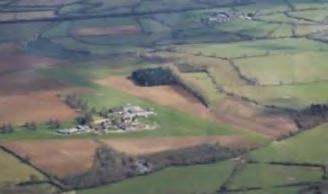








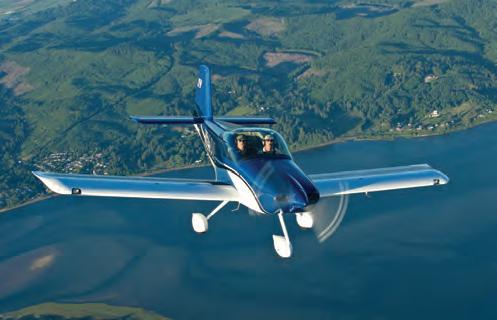

Clive Davidson gets a history lesson when he flies the vintage De Havilland DH85 Leopard Moth G-ACMA…
Pictures Neil Wilson

Readers of this magazine will probably recall an article last year about the adventurous around the world pilot Polly Vacher who, due to an unfortunate eye problem, had to retire from flying. As an aside, her Donkathon – a plan to drive a pair of donkeys on a 200-mile, four-week, cross-country from South Oxfordshire to North Wales to raise money for the MS Society – has, like so many events, been postponed due COVID-19. It is now planned to start on 25 June 2021 (https://www.donkathon.org). However, Polly and husband Peter (of restored Indian Hurricane fame) were the proud owners and instigators of the restoration of Leopard Moth G-ACMA, the subject of this month’s flight test.
The design was first flown 87 years ago in May 1933 and is similar to the earlier Puss Moth, the DH 80, with both offering a cabin for comfort and long-legged range. The Leopard has a plywood rather than a steel tube fuselage construction.
The Puss Moth was thought to have been created as a step beyond the open cockpit and tandem-seated Gipsy Moth, after Geoffrey de Havilland and his wife flew on what was probably a quite arduous flight to Morocco. Like the Leopard it has three seats, set with the pilot alone up front and two rear seats, but unlike its pull-out third bench, the Leopard has a quite luxurious double seat. The Leopard Moth enjoyed a production run of 132 aircraft, and Mike Alpha is one of six highly prized and airworthy examples within the UK – with several more in existence around the world.
Mike Alpha’s story begins when it was purchased from the factory by the National Benzole Company in March 1934 to replace their first aircraft, Puss Moth G-ABLB.
Named Mercury II it was flown by company pilot and Aviation Manager Mr J J Scholes, and was a regular sight at aviation events in the company’s chrome yellow and black colours with the winged-headed Mercury trade mark on the rudder, promoting National Benzole’s Aviation Spirit
As the war clouds gathered in 1939, ‘MA was one of 44 Leopard Moths impressed into Air Ministry service. It was repainted in RAF camouflage, adopted the serial number BD148 and, on 4 October, was stationed at Castle Bromwich with 7 Anti-Aircraft Co-operation Unit. Here it was used as a ‘target’ for the gunners to practise their aim, although not with live ammunition! One of its pilots during that period was Poland’s Stanislaw Slowikowski, who subsequently survived a mid-air collision between two Spitfires when flying with 306 Sqn. He settled in England after the war and died in Scunthorpe in 2005.
Having moved to HQ Army Co-operation Command Communications Flight at White Waltham in May 1942, ‘MA suffered a major accident (Cat B – not repairable at Squadron), and was sent initially to de Havillands at Witney for rebuild. It was then placed back with de Havillands themselves and used for communicating with various of their facilities around the country.
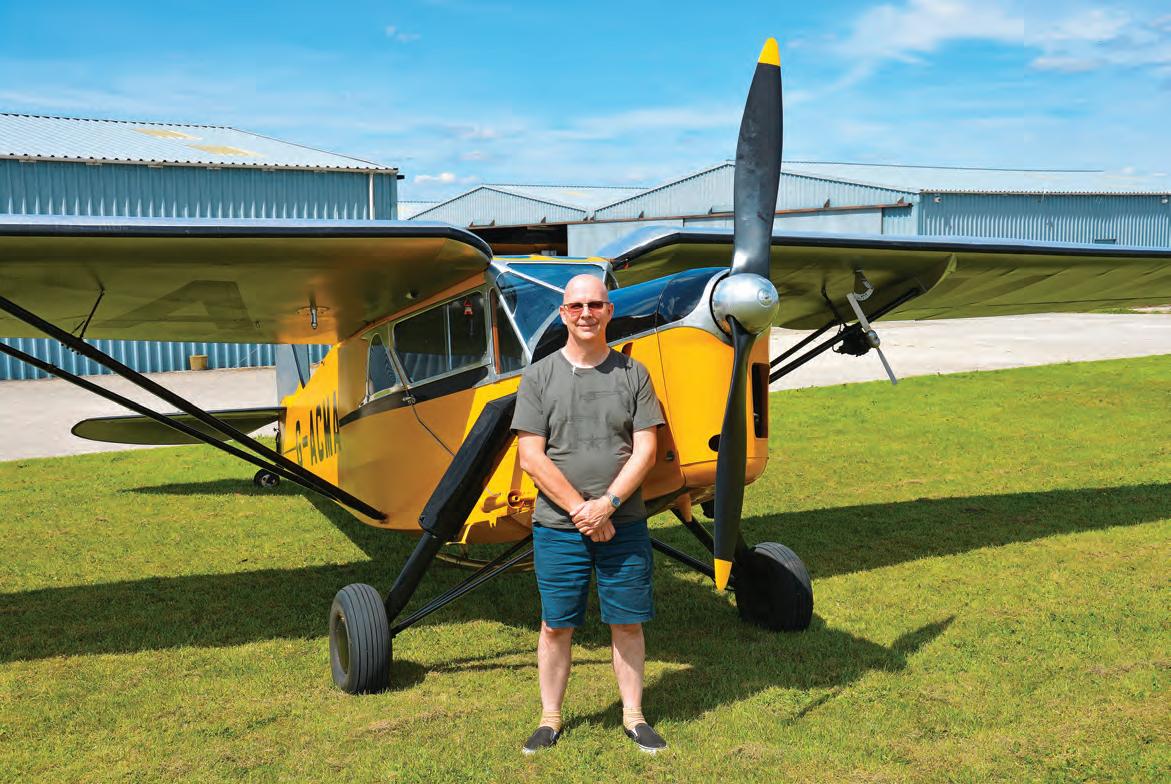


In February 1946, BD148 was sold to de Havillands, repainted and returned to its former registration, G-ACMA, and until 1953 was flown by the Company’s Chairman, Alan Butler and his wife, Lois, a former ATA pilot, out of their farm at Studham Hall. Sir Geoffrey de Havilland’s logbook, on 14 August 1952, records that he flew G-ACMA for 1 hour 35 minutes, his last flight as pilot in command.
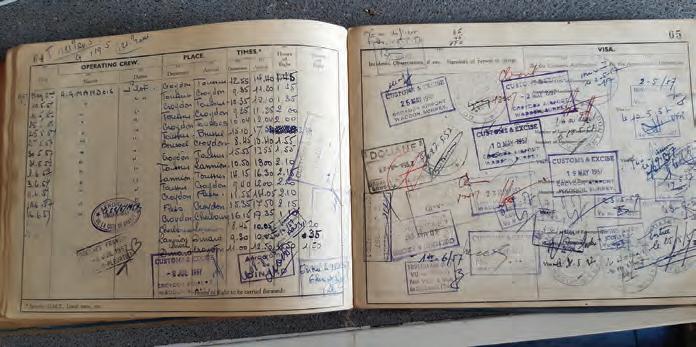
In 1953 ACMA was acquired by former ATA pilot, A J (Johnny) Spiller specifically to take part in the National Air Races. He competed as number 46 for the next two seasons, gaining a creditable fifth place in the Siddeley Challenge Trophy. However, in September 1954 the aeroplane was acquired by Wilfred T Scutt (Sales) Ltd and flown all over Europe by a Monsieur A G Mandois.
Mandois flew more than 90 cross-Channel trips in the Leopard, with flights to such places as Florence, Rome, Lyon, Dinard, Nantes, Epernay and Cologne. He flew to Toussus Le Noble Airport in Paris several times a week, amassing several hundred hours. Little is known of Mssr. Mandois, however, there is a Mandois Champagne connection, the vineyards of that company being in Epernay, at the heart of the Champagne region.
The Leopard was sold on 22 January 1960 to Allen Purcell who kept it for only a matter of months before it became the property of J P Filhol Limited in February 1961, being based at Bagington, the present-day Coventry Airport. The director, Stuart Filhol, moved to Cork in 1972 and commuted to Coventry in the aircraft well into the 1980s. Its last CofA was renewed at Booker in 1992. It remained at Bandon, County Cork until Peter Vacher was able to purchase it from Stuart’s wife shortly after his death in 2009. He had kept it for 48 years!
By the time Peter Vacher had acquired G-ACMA, it was in dire need of restoration and was put into the hands of Martin Honeychurch of the Newbury Aeroplane Company, with Peter assisting. Mark Miller, of de Havilland Support Ltd, was of great assistance during the seven-year long restoration, sourcing many original drawings and acting as the LAA Inspector for the project.
Above The mid1950s saw many European trips by owner Monsieur A G Mandois.
Top left New owner Cliff Hawkins is very enthusiastic about his delightful Leopard Moth.
Far Left Vintage panel with nod to modernity. Note superb workmanship throughout.
Left The rear seat, the back of which pulls forward to reveal luggage space. Dome on floor removes to fit control stick.
An aircraft’s log books certainly help relay its history, and two further names jump off Mike Alpha’s pages. She was flown by John ‘Cat’s Eyes’ Cunningham, CBE, DSO & Two Bars, DFC & Bar, AE, WWII night fighter ace and test pilot. And, on 24 June 1948, by Sqn Ldr John Derry DFC who, four years later, lost his life in the terrible Farnborough tragedy of 1952 in the prototype DH110, (Sea Vixen). His name is also linked with an aerobatic manoeuvre called the Derry Turn, whereby an aircraft in a steep turn changes direction by rolling through the inverted, to continue with another steep turn in the opposite direction.
Today, G-ACMA is in the stewardship of Cliff Hawkins, who will see her through the next phase of her incredibly interesting and active life.
When Mike Alpha came quietly onto the market, Cliff was completely taken with the idea of owning a vintage cabin monoplane, which came with such provenance and in superb condition. His own flying roots are deep. As a boy his father used to spray for Doug Arnold, whom you might recall dealt in very interesting machines, and Cliff would go with his dad and became friendly with Doug’s son. As seven and eight-year-olds they enjoyed themselves on bikes and karts, hoolying around the airfield. Doug took them in his Islander to France for lunch, and the tale he told me of when the two boys went for a flight in the single back seat of a Harvard had him in stitches and me agog! He has raced with the three Rs, the Royal Aero Club Records Racing and Rally Association in his RV-4 – and also owns a C180.
Cliff very graciously agreed to let us carry out a flight test of this, a living artefact from a bygone era, allowing us all to vicariously savour the joy of operating such a wonderful piece of history.
Watching the chrome yellow fuselage and silver high winged 'Mike Alpha S turning its way over the freshly cut grass at Henstridge was a visual treat. Cliff had obviously spent time preparing her for the photo shoot as the sun glinted from her at each turn. The large, slightly swept back, straight-edged wing drew the comment that it was probably just as well that the wings folded back for storage, as its span of just over 37ft would certainly be awkward to accommodate in a busy hangar.
Forward locking pins removed, and the inboard trailing edge section unlocked and raised clear, the tips are carefully swung back, pivoting on the strut to fuselage attachments, towards their resting place over and beyond the tail, its span becoming just 12ft 9.5in.
It was quiet too, not just that the wind was taking the engine noise away, but it has a long curved under fuselage exhaust, aesthetically matching the underside and muting her Gipsy engine.
Cliff could be seen sitting centrally in the front seat and he swung the tail in a sweeping arc as he drew near, ruffling the grass. A pause, a mag check, engine idle and a shut down. Silence. After the running of an aero engine, as perhaps the prop rocks against the next compression


Above Immaculate engine bay. Gipsy engine has electric start and a wind driven dynamo provides electrics.
Left Main gear ‘airbrake’ fairing deployed.
Below Wings fold easily to save considerable hangar space, it is less than 13ft wide folded.

with a slight wheeze and back again, there is a natural pause, a seemingly mandatory lull before the start of any movement and conversation. In our case it was one of greeting and the pleasure of arrival. It is so heartening meeting up with such cheerful enthusiasts.
Biscuits, coffee and a briefing of how the intended flight should be managed to acquire the required images followed in Tiger Moth Training’s portacabin. In the Moth, I was to sit in one of the rear seats, Cliff to fly from his normal seat upfront, with Ken Rhodes flying his SuperSTOL as the camera ship.
Brief over, I strolled across to the Leopard to note her attributes. The rudder features an aerodynamic balance, and the longitudinal trim is achieved by a variable incidence tailplane adjustment which is similar to, but earlier than that of a Piper Cub’s. The tailplane is double wire-braced, the two top wires running to the top of the sternpost and the bottom wires dividing to go to the bottom of the sternpost and farther forward onto the lower longeron. Moving forward, the screens are edged with exquisite polished alloy surrounds, which extend along the cowling and around the hub of the metal Fairey-Reed prop.
Some of earlier Puss Moths had suffered aileron flutter so the later Leopard Moth’s sizeable ailerons are equipped with mass balances that extend forward by about 30cm, bringing the control surface centre of gravity forward of the gap sealed hinge line.
As the aileron mass balances extend under the wing, they are clearly visible as the aileron is raised, but when the aileron is lowered the mass balances upward travel is restricted by the under-wing surface. This is not to say that the surface is the control stop – had further travel been needed the mass balanced would surely have an under-wing recess. Cliff was keen to pass on the interesting nugget that aileron could be used without rudder to turn, not usual in an aircraft of this vintage, so much so in fact that I hope I didn’t look too askance in response! Time would soon tell of course, but later I found some Pilot’s Notes stating that ‘rudder need only be used on the ground and for take-off and landing’. Intriguing.
Of course, flaps are not fitted – that inner section of the wing needing to hinge up for the wings to fold. However, a novel innovation was that the streamlined undercarriage struts can be swivelled 90˚ into the airflow as airbrakes, allowing a steeper approach to land. They induce a barely discernible pitch change when applied.
When you open the door, on the lower fuselage edge, what I am tempted to call the kick plate is a polished metal edging with ‘Leopard’ in ringed red lettering, and ‘De Havilland Aircraft Co. Ltd. Edgeware, England’ in black. A glance inside only reiterates the fact that this machine is worthy of the over-used phrase ‘a gentleman’s aerial conveyance’. In short, one cannot fail but be impressed by the opulent condition of the cockpit. The
texture of the carpet, the leather seating, the headlining, the silk plaited handholds above the doors and the period instruments set in a wooden grained panel, it is a wonder to behold inferring both quality and luxury.
There are pockets in the side panels and behind the pull-down seat back is space for golf clubs, far enough away from the compass so as not to distract its northseeking needle. There is also a netted hat rack. Had I known, I could have borrowed photographer Neil's Trilby or perhaps photo ship pilot Ken’s Homburg.
The instruments on the main panel are self-explanatory, the only questionable one being that to the left of the artificial horizon – it’s a clock that is modified to use as a journey time log. To some perhaps, the P11 compass nestling in its cubby hole at the bottom may also cause a furrowed brow – it’s what we old codgers used before they invented GPS!
A sober grey metal panel then extends downwards, the pilot’s legs astride it, and this houses the comms and electrics. At the top are the concessions to modernity, twinned Becker 8.33 VHF and transponder with a Garmin aera 500 GPS beneath. Period black volt and ampere meters follow and along the bottom are the various switches, with the fuses above, the master and generator being on the extreme left.
The central control column has a good lateral as well as a forward and aft throw, and there is an initially awkward to find, floor-mounted rudder trimmer on the right edge of the lower panel extension edge which can be twiddled clockwise to relieve tight foot pressure. Rather more obvious is the black metal circular elevator trimmer on the left fuselage side that works in the normal sense of wheel
Below The gentleman’s conveyance in the cruise, it is a very capable crosscountry machine. Note that lovely curved exhaust.
top forward to relieve forward stick pressure. Further aft and mounted on the inside of the leather covered door is the ratchet and lock of the park brake, and low down farther aft is the tail wheel lock handle, raised to lock and lowered to release. The swivelling undercarriage leg airbrake lever is mounted on the right-hand side of the panel, and is pulled down to deploy the airbrakes.
The throttle and mixture levers are high and forward on the left fuselage side, the throttle having a catch so that when throttling back it returns the mixture to rich.
There is a graduation of one to 10 by the throttle, one being fully closed and 10 fully open. Cliff tells me that the 3.7 position returns his chosen revs for cruise. I must admit to marking my own throttle too, ever since being told a disastrous tale by a now elderly Beaufort pilot who used to mark his throttle and mixture at the correctly leaned position. On a night raid, all 12 of the squadron took off and only he and a friend returned. Not having briefed the crews, the engineering officer had all aircraft modified to carry the latest exhaust shield so that the Luftwaffe night fighters supposedly couldn’t see their aircraft as a bright set of flames in the night sky and home in on them from behind. Unfortunately, the pilots couldn’t see their own yellow white rich exhaust flames either, and lean them to turn an optimum purple blue hue.
My position today is the back and having sat in the left-hand side, Cliff leaned in from the open right door, tipped the front seat forward, removed a bevelled metal cover and attached a stick for me, securing it with a pin. I could see where the rudders might have joined but, regretfully, we didn’t have that option. I really was going to test rolling with just the stick!
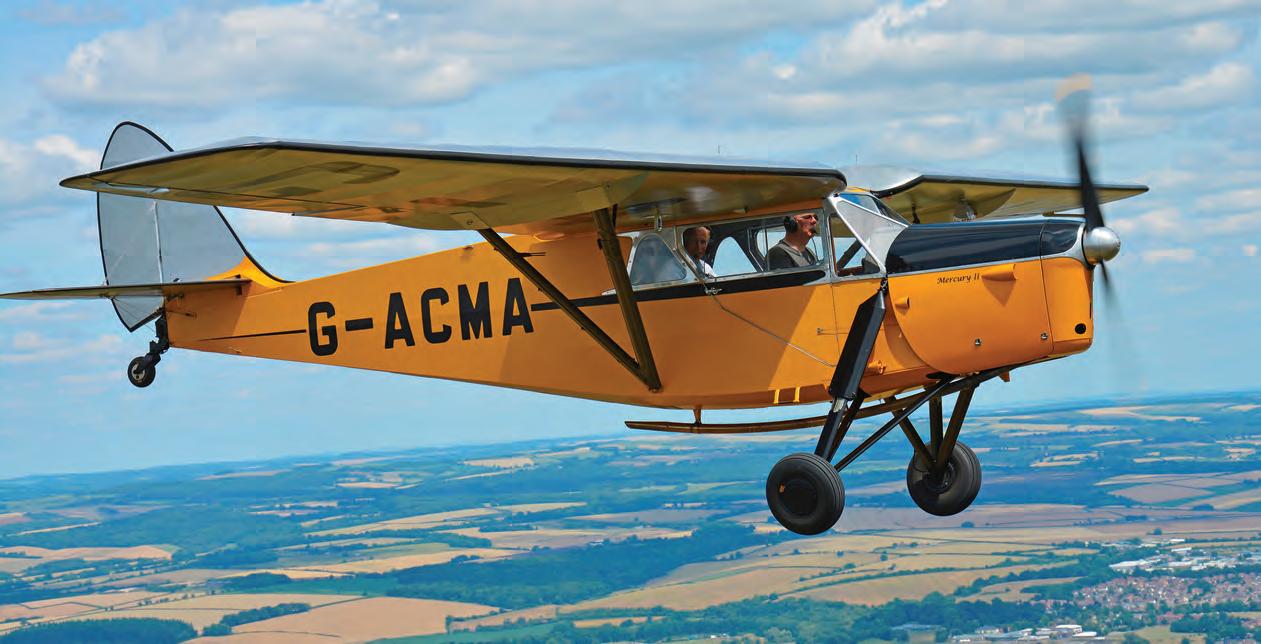
My view forward was no more awkward than looking forward from the back seat of most tailwheel aircraft, but –and it is a bit of a ‘but’ – otherwise I could only look downwards and level to the underneath of our high wings. This is potentially awkward with formation flying when a good field of view is a high priority.
Looking out onto both undersides of the wings there are fuel gauges of the plunger in a glass variety giving an accurate-ish reading when level. The grey leather seating is comfortable, and my long legs are hugging the front seat, Pitts S2-esque. I have a modern four-point harness and a skylight above. Cliff briefed me on how to pull the red toggle above my head to release the Perspex skylight so as to exit, should we have an upset. Good to be briefed for all eventualities…
The start is à la Chipmunk, intrinsically it is the same engine, a Gipsy Major 10/1 with an electric start, rated at 130hp at 2,400rpm. The mag switches are definitely down and ‘off’, both wing fuel tanks ‘on’, the left cowling raised, and the front fuel pump lever activated to fill the carburettor and then the cowling closed and locked.
Back in the cockpit the throttle is nudged open a quarter to half an inch, a good look around and ‘Clear prop!’. The right impulse mag is up and ‘on’ and the starter
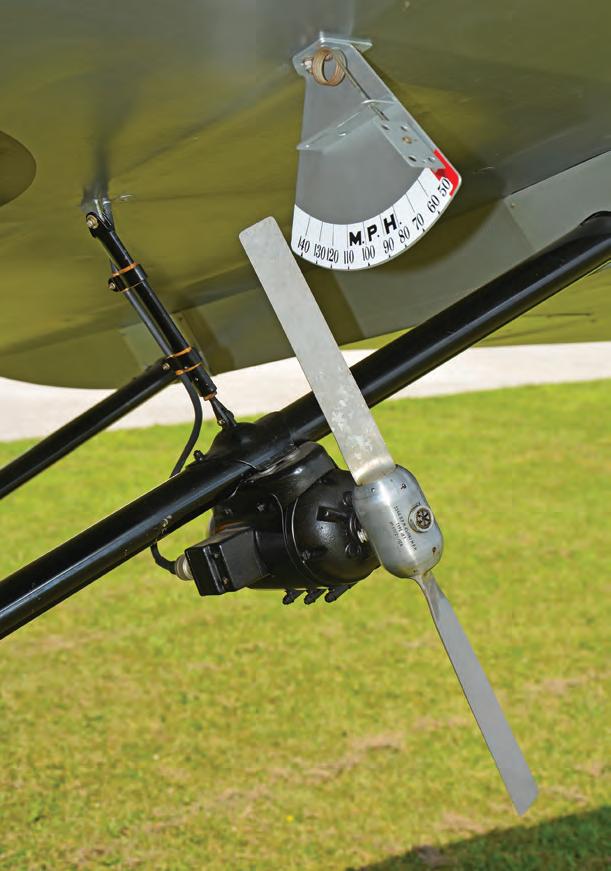
is pressed; she fires earlier than the five blades-plus that I had anticipated counting. Both mags up to on and she settles at 800rpm in a relaxed, unhurried manner to warm before rolling. The oil pressure settles between 35-40 psi. A plug/mag check can be carried out at 1,600rpm and should a static rpm check be required, no more than 10 seconds duration would be sensible.
Before opening the throttle after the Captain’s brief as to what our actions will be should we lose power (there are some good fields ahead if needed) the P1 can look up through glazing at each of the left and right distinctive red wing locking mechanisms to confirm they are truly set fore and aft in the locked position, and not flush with the leading edge. Very reassuring and better now to have such reassurance and confirmation. And on that note, the rear inboard sections of the wing that were raised to allow the wing to pivot back, must also be locked down into place as well. Apparently one gentleman long, long ago got airborne with these unlocked! They floated quite naturally upwards into the low-pressure area but did not affect the handling too adversely… not that I have any desire to experience this reaction for myself.
Lined up with our tailwheel locked, the airbrakes in (they can flex open taxying over rough ground) and ready for our turn for take-off as number two in the trail formation departure, ahead the SuperSTOL leapt off the ground in short order. Cliff applied the power judiciously to full, keeping straight with rudder and kept the stick back and the Leopard's tail on the ground, while I counted silently to four and then, ghosting the stick, by eight we were on the mains with the nose lowered and she rose before the first taxiway in circa 200 yards.
Normal climb speed is 70mph and the original climb performance was quoted as 550ft per min, but today we are light of fuel and way under the max take-off weight of 2,225lb, and a feature of the current FaireyReed prop is that it is slightly on the fine side. This gives us improved climb performance but does reduce the cruise speed to less than optimum, so a new prop is being sourced. The desired new prop, the same as Henry Labouchere has on his Leopard Moth, returns a speed of 110mph at 1,900rpm. Into the cruise with 2,150rpm set, we have an indicated speed of 100mph and a fuel burn of 5.9 imperial gallons (26.8 litres) an hour, fuel capacity being 35 imperial gallons (158 litres). One litre of Straight 80 per hour is a good average for oil use.
The original specs claimed still air range is 715 statute miles, so along with its design as a go places machine, with crew in a comfortable cabin, and high-wing enhancing pendulous stability, it was no real surprise to find her completely stable in pitch.
From the release of crossed controls from steady heading side slips, her reactions showed positive directional stability. Lateral stability, the wing’s
tendency to return to level, isn’t pronounced and the ailerons’ low speed effectiveness is of the same standard, although their character sweetens markedly above 70mph.
I was keen to try single control turns – first the rudder, and the results were good. The gentle initial yaw in the direction of applied rudder swung the nose as anticipated and then the accompanying roll brought us around to a new heading that could be stopped, and held, with the wings returning to level. But I only induced a gently banked 15° turn, preventing the angle of bank increasing by feeding in opposite rudder almost as soon as the wing lowered.
Now for the claim that rudder was not necessary in the cruise. Well, I have to admit, and it certainly surprises me, but it is true. Applying the aileron in a natural tempo you may roll on bank of 30° and the nose will not show an iota of desire to first swing out and away in yaw from the direction of the turn. Very commendable. If I were being churlish, by rolling into a turn in one direction and then, as soon as bank angle was established, rolling back in the other direction rather than centring the stick, the nose shouts foul and will certainly go in the opposite direction to the applied roll.
However, that is not the manner in which this touring aircraft would normally be operated, and on a long trip, slight heading corrections by stick alone from a tired pilot who might normally use balancing rudder, can be appreciated as a helpful trait.
Slow flight had seen a reduction in the feel and response of the ailerons but the stalls themselves were gentle enough, telegraphing the fact that the inevitable was approaching so nobody should be caught out. Stick promptly forward solved the difficulties. The recordings we got were lower than the book figures – our stalls showed
Below Tailplane is wire-braced and used changing incidence for trim. Tailwheel is locked for take-off and landing.

the ASI flickering around the mid-40s, but we were not heavy. Book figures are 50mph at 2,225lb and 46mph at 1,850lb, suggesting approach speeds of between 60 and 65mph depending on weight.
In practice, Cliff flies downwind at 100mph with 2,150rpm set, and among the standard checks ensures the tailwheel is locked to aid directional stability once on the ground. Base leg has the swivelling airbrakes unlocked and flat to the air and 70mph on the ASI – this is a sound compromise between aileron response and a safety margin above stalling. The curved approach view of the nearing runway is exceptionally good, even from the back seat. Cliff uses the approach control technique of speed with the sick and height with power, the aim being to arrive level over the undershoot / threshold at 65mph and then three point her.
It is only now fully aligned with the runway straight ahead that I have lost the view with the fellow in front and rely upon peripheral vision to confirm Cliff’s technique, settling smoothly onto the ground.
The undercarriage is beautifully damped on the odd undulation of the grass, producing an impressively smooth run. I expect the pilot may also have had something to do with it! Cliff has 33 flights logged on her now.
Other than thanking Cliff for the delightful session aloft in his gorgeous machine, I have one further comment as I was drawn to his tee-shirt with a three-view drawing of his Leopard Moth, quite appealing and distinctive.
When Monday and wash day appears, my clothes line shows my tee-shirt collection of varying aircraft, everything from Europas, the Stewart Mustang and my mates in the Czech Republic – the Pterodactyls, who fly a range of WWI replicas. All have white backgrounds.
However, Cliff’s is definitely a dark grey, and is spotted with an ever-expanding accumulation of oil blotches. He shrugs as he admits to it being the only suitably sartorial top to wear. After all, he does own a ‘Dripsy Major’… ■
General characteristics
Crew: One
Capacity: Two passengers
Length: 24ft 6in (7.47m)
Wingspan: 37ft 6in (11.43m)
Height: 8ft 9in (2.67m)
Wing area: 206 sq ft (19.1m2)
Empty weight: 1,290lb (585kg)
Max take-off weight: 2,225lb (1,009kg)
Powerplant: 1 × de Havilland Gipsy Major 4-cylinder, 130hp (97 kW)
Propellers: 2-bladed fixed-pitch propeller
Performance
Maximum speed: 137mph (220km/h, 119kn)
Cruise speed: 119mph (192km/h, 103kn)
Range: 715mi (1,151km, 621nm)
Service ceiling: 21,500ft (6,600m)
Rate of climb: 550ft/min (2.8m/s)

After a season of disappointing cancellations, the Lundy Island Fly-in went ahead with 80 aircraft flying in to this unique venue, as Pete White reports…
My love affair with this remote three miles (5km) long, and by a little over 0.6 miles (1 km) wide craggy island in the Bristol Channel began 20 years ago, on 27 January 2000, when I landed Aeronca Chief, G-IVOR, on the airstrip for the very first time.
Named Puffin Island by the Vikings in the ninth century, a resident species for which the island remains famous to this day, the island has had a varied and interesting history, including private ownership by the Harman family from 1925 to 1968. It was subsequently sold to the National Trust, and the Landmark Trust took over the reins of management.
The magic of this historic kingdom soon captivated me and the urge to keep returning has not ceased to this day.
In that first year that I visited we, the Devon Strut, attempted our first fly-in there on 27 August, and this started an annual fly-in which has continued to this day. In fact it has become a ‘bucket list’ venue for many pilots.
After 10 years, the Devon Strut stepped back from Lundy as a dedicated event, but I continued to run the fly-in with a small team – The Lundy Team – working in conjunction with the Lundy Island management. So, Lundy Sunday was born and, although over the years our main
Above Approaching Lundy. The strip runs across the island, the line up of aircraft can be seen just forward of the rear strut and the runway heads in the general direction of the lighthouse. Photo:
enemy has been the weather, our fly-ins have always been an enormous success, even if conditions have sometimes restricted us to a smaller attendance.
One year we had to cancel because the foot and mouth epidemic prevented us from using the site, as happened with many other events in the UK, including the annual Rally. But 2020 will be remembered for COVID-19, which has put paid to just about every event imaginable, not only in the UK but across the world. So, when we were finally given the green light from Lundy to go ahead, we were over the moon.
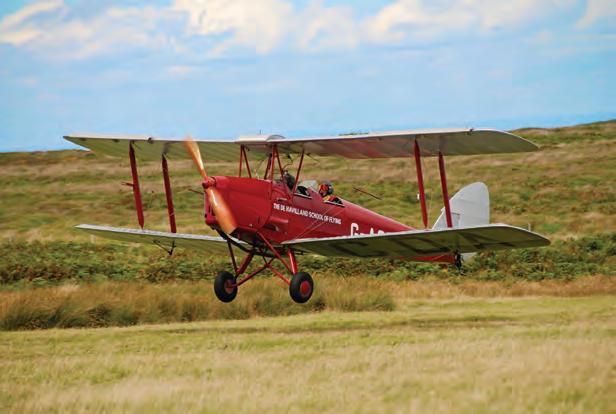


It was also very fitting that 20 years after our very first fly-in on the island, that our 2020 Lundy Sunday on 2 August was a raging success with no less than 80 aircraft attending. The wind was generally in the right direction, plus it was strong enough to move the showers on fairly quickly so we could dry out, ready for the next wave of visiting aircraft.
Running a unique event of this nature would be impossible without the help of a small band of enthusiastic volunteers who had all flown in specifically for the purpose.
Our hard working team on the ground were John Colgate, who helps run the event with me as well as sharing our lovely Aeronca Chief; Martin Ryan, owner of a rare Stinson 108 and a damned good egg; Richard Saw, who flew in with his Auster Autocraft with his passenger Nigel Ramsey, another helper; and last but not least Bill Thirtle, who brought his delightful little Piper Vagabond. An interesting observation is that we all fly vintage types, and among the incredible range of assorted types that attended the fly-in we had 30 vintage aircraft.
Many of the attendees this year had not flown into Lundy before, although we had our regulars who just love to return to enjoy the ambience and peace of this simply extraordinary place. From the safety aspect, the Lundy management are on duty with a fire truck and full rescue equipment and assist with other tasks when needed. Thanks guys.
Above Eighty aircraft flew in and out, exercising exemplary airmanship. They were a very diverse and colourful selection of Permit and CoA types.
Left One of a veritable gaggle of Moths which made the trip across the Bristol Channel to be part of Lundy Sunday. Photo: Neil Wilson
It is not practical to give a full list of all the aircraft that chose to visit, but I must highlight some special moments. For instance, looking up and seeing a formation of five Tiger Moths in the overhead, part of the Tiger 9 team, led by Jeff Milsom. After they had expertly landed we had another type join them from the same stable, a Hornet Moth. I thought we had been very fortunate earlier to have the company of two rare Fairchild 24R Argus aircraft in our midst among the early models of Piper, Aeronca, Auster, Cessna, Stinson and Jodel types. Yes, you have probably guessed, I am very much an enthusiast of older aircraft.
Worthy of mention, is that among the flight of three Piper L4 Cubs that arrived, one was flown in by the young Ellie Carter who, at the age of 17, was certainly the youngest pilot of the day and it was her first visit to the island… so, well done Ellie.
We had an extremely successful day and the fact that 80 aeroplanes arrived and left without incident demonstrates very good airmanship. I must thank our visiting pilots for digesting the ‘Lundy brief’, which we send out after they have registered for the event. It is imperative that we insist on PPR as the airstrip can be a challenge.
Thank you all for visiting and making our Lundy Sunday Fly-in such a special and unique event. The 2021 event is planned for Sunday 1 August, so see you next year. ■
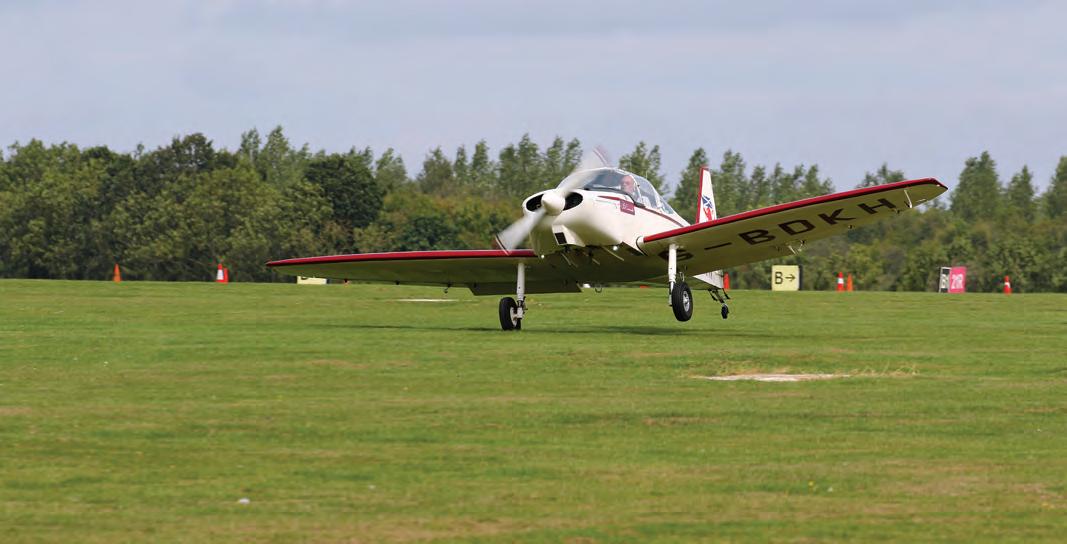
As we slowly continue to come out of lockdown I was musing, along with reading numerous articles on the same lines, about the fact that many of us had not have flown for some time. Solo flying had its limitations but thankfully dual instruction is also now allowed, so, while we maybe have now become current, how proficient are we?
Currency and proficiency are not the same thing.
The ANO sets minimum standards for currency, which has a lot to do with staying legal, but not much to do with being a competent pilot. We all hopefully remember the ‘three landings in 90 days’ rule and many of us are governed by either our own group currency rules or maybe the standing orders of your flying club stating something along the lines of, ‘if you want to rent then you must fly the aircraft every 30 days’.
We can all look up the airspace rules about ‘visibility’ and ‘distance from cloud’ etc, but are we able to actually fly in conditions that are close to the minimum limits specified? After all, three kilometres visibility is only around two runway lengths of most small airfields and airstrips!
Bottom line? Flying is not just like riding a bicycle. Individual needs vary, but for the majority of us, meeting the above requirements (and nothing more) is simply not enough. The obvious solution to the currency problem is to do more flying. But when it comes to
Above This Emeraude pilot was landing at last year’s Rally in a 90° crosswind from the right. He is literally in the process of touching down after kicking it straight and putting aileron into wind for a clean touchdown. Such skills demand proficiency as well as currency.
proficiency – being prepared to handle any situation with which you might reasonably be presented – quality actually beats quantity. Fifty hours of circuit work in the past year, all of it on benign days, might make for smooth light wind landings, but it will not count for much the first time you’re faced with a 15kt crosswind.
Both currency and proficiency have similar definitions and they do complement each other, but neither one is a replacement for the other. Being current means that you have met the requirements to act as a pilot in command of an aircraft within a certain period. Being proficient, according to the OED, means the ability to do something well because of training and practice. You can be current without being a proficient pilot, but if you are proficient, most likely you have also met the currency requirements to get to that point.
If you lose currency you probably also lose some proficiency, but currency is one (and only one) factor affecting proficiency.
Learning how to become current may be as easy as reading the training manual for the type of flying that you are going to do. To act as pilot in command of an aircraft, you need to have accomplished your ‘one-hour
with an instructor’ or a ‘proficiency check’ within the preceding 12 calendar months. To be able to carry passengers, we all know that you need at least three take-offs and three landings within the preceding 90 days. For night flights with passengers, one of the landings needs to be full stop at night, not touch and go.
Many of the articles and studies that have been collected on this subject stress that one can meet the above currency requirements without becoming proficient in the operation of an aircraft.
Proficiency in an aircraft includes not only the knowledge and skill you need to operate normally, but also those you may need when things go wrong, such as knowledge of the emergency procedures for the aircraft that you fly, as well as type of flying. Maintaining proficiency in aircraft of different categories and classes can be more of a challenge due to the different skill sets that are required.
The main similarity is practice. To become proficient, you should practise your skills in an aircraft. It is best to do this with an instructor to make sure that you are doing so correctly, but you can also achieve this on your own.
There are many ways to become a proficient pilot; one way is to become current and then practise more on your own until you feel you are fully competent in the aircraft. You can also solicit assistance from many sources, including an LAA Coach, an Instructor, or even

Above For navigation practice, some of the PC simulator programs are very useful.
a computer software program. Practise what you know and then develop further onto more complex things.
Practising performance manoeuvres by yourself is not as rewarding as demonstrating your skills to another pilot. You do not always have to fly yourself under the watchful eyes of a Coach, because a fellow pilot can still demonstrate ways to perform a smooth short field landing that may have been taught to him or her differently.
If you want to practise a manoeuvre that you do not normally perform, such as soft field landings, then an hour or two of instruction from a Coach is likely to accomplish much more than a number hours of going through it on your own.
One of the newest areas of training that you can use to your advantage is the use of computer simulator programs. Using an inexpensive VFR simulator or Navigation program can provide good graphics for the procedures to improve navigation techniques.
The ‘feel’ of a simulator ‘aircraft’ may not be what you are used to, but the programs are getting better as the technology improves. ■











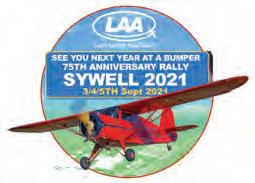






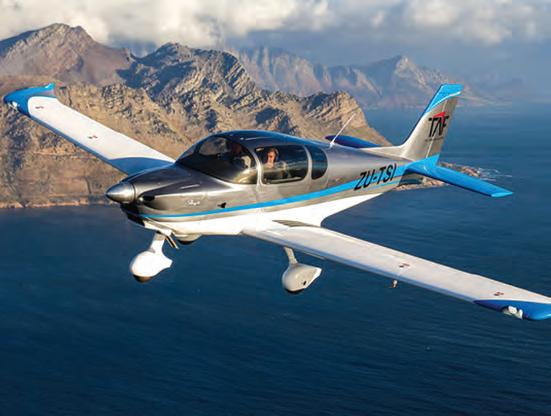
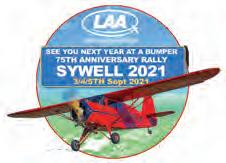


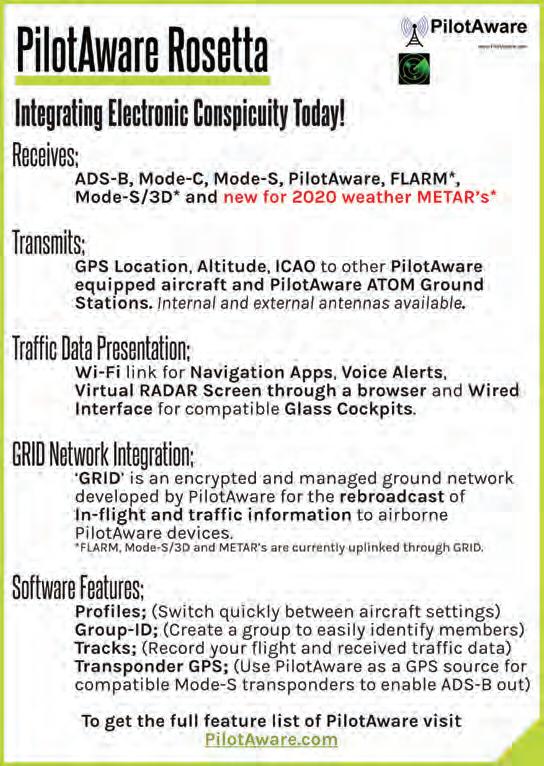

Malcolm
at the importance of close inspection of control systems and flight control attachments, and the issuing of
Hello again, and welcome to this ‘approaching autumn’ edition of Safety Spot. I hope that before you begin your read, you’ve checked that your shoulder harness is properly adjusted, that you’re securely strapped in and that your controls are full and free. Well, OK, although we do tackle some quite complicated subjects in Safety Spot, I’ve never actually received a report of a member being thrown from their armchair as a reaction to a difficult sentence… But, reminiscent of a voice from the past – ‘are you sitting comfortably’?
For the first time in some months, I begin this month’s offering sitting at my desk at our Turweston HQ. It would seem to me that we, in the UK at least, appear to have passed through the worst that COVID-19 can throw at us and, as you are reading this, we look – hopefully – to be at the other end of that tunnel. Commercial aviation has taken a battering though, and I guess that many of you reading this will be facing different futures than you might have predicted for yourself, and probably worked hard for, just six months back. As always, of course, we do hope that you, and those you love, are faring well through these extraordinary times.
The last 100 years or so has seen aviation develop such that it is now an integral part of a human way of life, effectively we have evolved into a being that can fly. Though all transport systems remain disrupted, and perhaps many of us have enjoyed the relative quiet afforded by this, personally I have absolutely no doubt that both sports and commercial aviation activity will return to pre-Covid normal levels sooner rather than later – flying, after all, has just become too important for us all.
Of course, one of the key reasons why human flight has progressed in the way that it has, must be that most consider it a safe way to both travel and, for some, enhance our leisure time. Aviation safety is not there by accident – all aviators instinctively know this, and we all work as a team to keep our brothers and sisters as safe as possible, that’s what Safety Spot is all about. It’s generated by your reports, nothing’s ‘made-up’, the accounts you tell generate safety messages that will resonate through time. We ignore past safety lessons at our peril, and ‘past’ shouldn’t be confused with ‘passed’…
In this month’s Safety Spot, we feature three engineering incidents which highlight the great importance of close inspection of control systems and flight control attachments. But before we delve into this realm, we should explain why we’ve had to issue an Airworthiness Information Leaflet changing the position of the pilot moment arm on the Bristell NG-5 aircraft – this being, of course, a key dimension when calculating an accurate centre of gravity before flight.
In June 2019 a Bristell NG-5 aircraft, operating in Eire under an LAA administered Permit to Fly, crashed during a routine familiarisation flight. Very sadly, both occupants of the aircraft were killed in the accident. The accident investigation is being led by the Irish Air Accident Investigation Unit, the AAIU and, like all accidents there are many candidates when it comes to identifying the root causes. The AAIU’s work is impressively thorough, which is as it should be of course.
As part of the detailed investigation, the leading AAIU Investigator became aware that the pilot moment arm listed in the Pilot’s Operating Handbook (POH) for the aircraft, didn’t appear to be correct. The POH defines the position where the pilot and passenger’s weight will act on the aircraft during flight, the pilot moment, as being 600mm behind the aircraft’s datum. We were asked to carry out a check-weighing of a Bristell so that the actual position of the pilot’s moment could be calculated.
After a number of checks, first by us, in conjunction with the UK AAIB, and then by an independent company specialising in aircraft weight and balance matters, the position of the pilot moment was found to lie somewhere between 700mm and 750mm aft of the aircraft’s datum, in the worst case some six inches further back than the ‘book’ figure. The reason for the 50mm ‘area of uncertainty’ is, naturally, that no two people’s centre of gravity (CG) falls exactly in the same place – long muscular legs, just for example, will tend to push a CG forward when the owner of the legs is seated in an aircraft cockpit. I shall refrain from further morphological examples, we are all different, and of course beautiful in our own way. But you get the message I hope – when it comes to personal CG positions, shape and size matter.
LAA Engineering wrote to all UK NG5 owners in July to advise them to adopt a conservative 750mm moment arm figure in their weight and balance calculations until further notice, while the matter is resolved. It was pointed out that, in some cases, this might lead to more restrictive crew payload capability to keep within the aircraft’s aft CG limit.
The aircraft’s designer, Milan Bristela, is working up a POH amendment to correct the anomaly, in discussion with our Chief Engineer, Francis Donaldson. After doing his own weighing tests at his Czech base, which broadly matched our findings, Milan is looking at ways to reduce the impact this change will have on the aircraft’s overall loading capability in the long term.
LAA Engineering has mandated the ‘most aft case’ position (750mm) for the pilot moment on the Bristell aircraft in its fleet using an Airworthiness Information Leaflet (AIL), which has been sent to all Bristell

Simple aviation incident statistics seem to show that in most cases the reason for an aviation incident or accident lies with the brain, hands and feet of the pilot. We used to call this ‘pilot error’, nowadays we’ve rebadged this primary cause as a Human Factors event, or HF for short. Of course, there’s always more than one way of looking at something and, with my engineering eye, and I hope not being too defensive of my
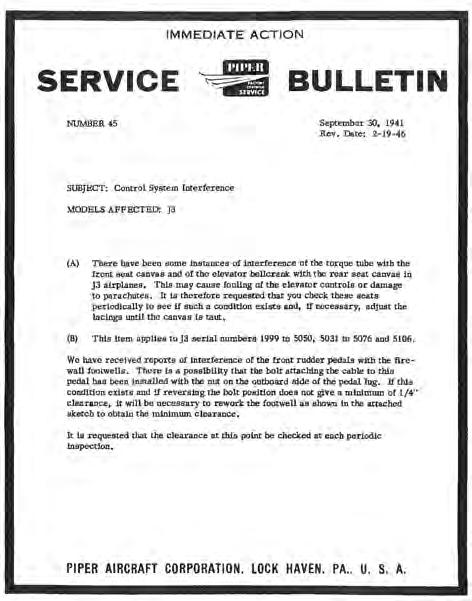
NG-5 owners individually. The aircraft must only be flown within the weight and CG limits defined in the aircraft’s Operating Limitation document, as tested during the LAA’s stability and handling evaluation on the UK model of the NG5 when the type was introduced into the UK.
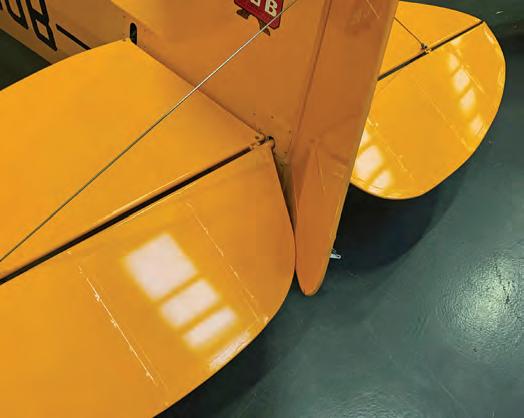
Above This Piper Service Bulletin, SB45, was first published in 1946 and relates to potential control system interference between the canvas seat and the elevator and aileron control system on the Piper J3. It also discusses a similar problem where the rudder pedal could, in some cases, foul the firewall footwell. The dangers associated with a control system jam, for any reason, are obvious and the inspection requirements listed in the SB were soon mandated by an FAA Airworthiness Directive (AD 47-50-03). The fact that an AD or an SB was written in the distant past, does not devalue their content and, for many aircraft in our fleet, they remain ‘mandatory’ documents.

limited pilotage skills, it’s a rare incident that doesn’t have some kind of ‘engineering’ issue lurking within the story.
Aviation engineering is, after all, a broad-based discipline. Naturally, one thinks of the designers as being the lead in the adventure but, clever as they are, their task is often quite a straightforward one – to meet a set of predefined targets. Aircraft design is, more usually, a stepwise process… a basic design being tweaked into an ‘improved’ model.
Side by side with a design team are the certification and approval engineers, the people that check that all the elements of a design comply with the many existing requirements. These requirements, interestingly, follow the same basic evolutionary process as the aircraft they support, one requirement on top of another through history.
Earlier, I alluded to the fact that it would be a sad day when lessons stopped being learned from an aviation incident or accident. But it’s not just learning new lessons that is important, remembering the old ones is just as important, perhaps more so.
As an aircraft operator it’s most likely that the aeronautical engineer you’ll get to know well is an aircraft maintenance engineer, probably in the form of your LAA Inspector. Theirs is a particularly difficult job and, to do the job well, they really need to be considered as a full partner in the operation of a particular aircraft. After all, there’s a lot going on, both in the life of the owner of the aircraft and the life of the aircraft itself.
To create an effective maintenance regime, a Tailored Maintenance Regime, personal finances can play as big a part in a decision-making process concerning an engineering matter as anything else. It’s easy to say, ‘this or that isn’t perfect – change it’. It’s a much harder decision calculating whether there’s an increased risk in leaving a worn bolt in place until next year, and whether to accept the ‘less than perfect’ part so that something more urgent can be done – a pound will only stretch so far after all. LAA Inspectors are asked to make these sorts of decisions all the time, it requires a very special skill set.
One thing that’s certain, if something’s failed in the past, then chances are it could fail in the future. It is therefore essential that both the inspector and the owner of an aircraft work hard to gather as much of a type’s failure history as possible before they begin their inspections. Often, this information takes a bit of teasing out. Just like an aircraft designer, or a certification and approval engineer, an aircraft maintainer must have one eye on the past to ensure a safe future.
I received a call from LAA Inspector, Matt Pettit, he was a bit concerned about a couple of, in his view, snags he’d come across when a very nicely presented Piper J3 Cub came to his workshop to have an engine problem sorted out.
Matt is an aviator and an aviation engineer through and through, he has an eye for detail and, importantly, recognises the importance of being thorough in listing (and understanding) the failure history of a particular type.

Before Matt begins his inspection, he will always check whether any Airworthiness Directives, Manufacturer’s Service Bulletins, Mandatory Permit Directives or Airworthiness Information Leaflets apply to the aircraft being presented to him. There’s no point at all, in Matt’s view, starting an inspection today without having one eye on the past. I completely agree, as an LAA Inspector I’m all too often confronted with aircraft log-books with nothing written in them but the aircraft’s hours.
The J3 in question is clearly a much-loved aircraft, and the owner a diligent and competent pilot – but it’s not clear from the log-book entries that all of the applicable Airworthiness Directives or Service Bulletins had been complied with.
Two things worried Matt, and it was these that he felt that it was important to report.
The first was that the rudder was impacting the elevator when at full deflection, and marks on the rudder suggested that this had been occurring for quite some time. OK, during normal operations this probably wouldn’t affect safety, but what about recovery from an unintentional spin, or during a tricky crosswind landing that sudden gust full rudder and a stuck elevator wouldn’t be helpful.
It turned out that non-standard stops had been fitted at some stage in the aircraft’s 76-year life, using ferrules clamped to the rudder cables rather than fixed stops welded to the structure. These clamped-on stops had apparently slipped at some point, allowing the excess rudder deflection.
Below are pictures of the canvas seat from the aircraft. There’s a 1946 Service Bulletin emphasising the need to ensure that the fabric of the seat cannot foul the controls, an obviously important requirement based, no doubt, on a past and probably long-forgotten personal disaster. I’ve heard owners say, ‘it’s on a Permit now, these requirements don’t matter any longer’. Wrong, as I hope I’ve explained above. As the aircraft ages, requirements created in the past matter more, not less.
This seat SB is mandated by an FAA AD, which looks to have been published a year later, and it’s still a legally enforceable document.
Clearly, at the time the J3 was more prolific than it is today, and loose or damaged seat bases were becoming an issue. Both the SB and the AD are sometimes misread – some inspectors apparently believe the AD only applies to the rear canvas seat hammock, which could cause greater potential control restriction. However it applies to the front seat too.
If you own an aircraft, especially if it’s a type with a long in-service history, why not spend the approaching winter’s evenings compiling an AD, SB, MPD, AIL compliance checklist. Next time you present the aircraft to your LAA Inspector for its annual Permit check, you might just get a smile rather than a grimace when he or she checks your log books!
Though thorough inspections and regular maintenance will

unquestionably reduce the probability of an inflight component failure or other engineering-related problem, all pilots know that the chances of something going wrong with the aircraft they are flying will never be reduced to an absolute zero. We received an email from LAA’er, William Boyd. He’s recently introducing a Rans S-6 microlight aircraft into his family and, on a cross country trip in August, he noticed that things ‘just didn’t feel right with the aircraft’. Here’s some of his emailed report.
Hi Malcolm,
I acquired my licence in November 2019, but I had purchased the Rans in September 2019. It was bought from a gentleman in Letterkenny (RoI) and was then kept in a barn on my grandfather’s farm in Ballymoney (NI). I had intended to complete work on it there as there was no hangarage fee. I was, however, convinced to change this plan and hangar it at Newtownards Airfield upon the advice of an instructor there. Here I began preparing the plane to obtain its permit.
In retrospect, I think it would have been advisable for the aeroplane to remain at Ballymoney until work had been fully completed, as once paying for hangarage I felt more pressure to fly the aeroplane, so a total strip down did not occur. Previously this aeroplane had only flown one hour per year for the past five years, so it required some attention.
On the day of incident, another pilot and I loaded the aeroplane with fuel and set off for Bellarena Airfield (NI), a distance of 62 nautical miles. On approach to land, I discovered that I was higher than required so decided to side-slip the aircraft down to a normal landing. I taxied back to Bellarena clubhouse where I was quickly told to turn and leave. The traffic controller was concerned that there were too many aircraft present during COVID-19.
I then took off and headed towards Causeway Airfield (NI), which was 14 nautical miles away. During climb-out, I experienced a swaying motion from the rear of the aircraft, which quickly dissipated. Twenty minutes later I had landed at Causeway and took a good look around the aircraft to see why it was behaving erratically in yaw. I discovered that the bolt holding the front of the vertical stabiliser in place had sheared off, leaving only the captured nut behind. The top aft cables had been stretched, showing the amount of stress that had been put on the vertical stabiliser.
Thank you William, I think that you are right to point out that it’s always a good idea to get to know a new aircraft in slow time, and this is often best accomplished by carrying out a strip inspection. On the other hand, as a fairly new starter, both to pilotage and to aircraft ownership, it’s also a good idea to be close to more experienced flyers.
We managed to extract the remains of the sheared bolt here at Turweston and, as you can see from the pictures, the AN3 bolt has failed across the wire locking hole because the hole is just at the point of maximum tension in the anchor nut. In short, the wrong bolt was used.
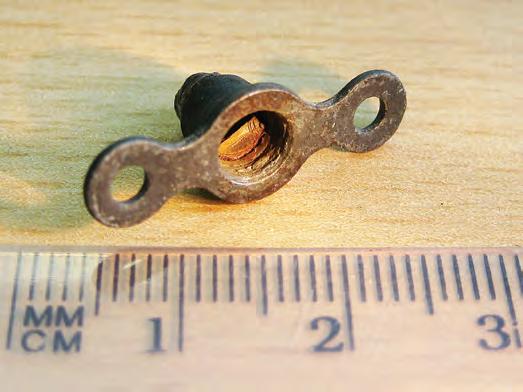

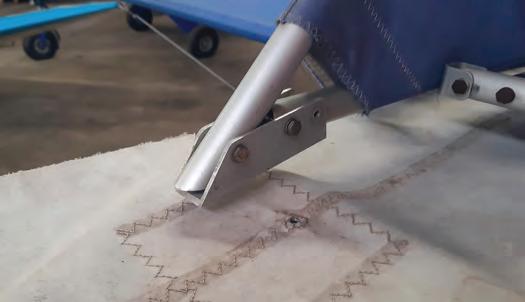
Above When Rans S-6 flyer William Boyd took-off from Bellarena Airfield for a short flight to Causeway Airfield, he noticed that the aircraft was ‘swaying’ unnaturally from side to side. The aircraft remained controllable and, once settled into the flight, the uncommanded yaw stopped. On landing he took a look round his machine only to discover that the bolt securing the forward fin tube to the fuselage had failed and the fin was being held loosely in place by the flying wires. Photos: Rans Aircraft/William Boyd

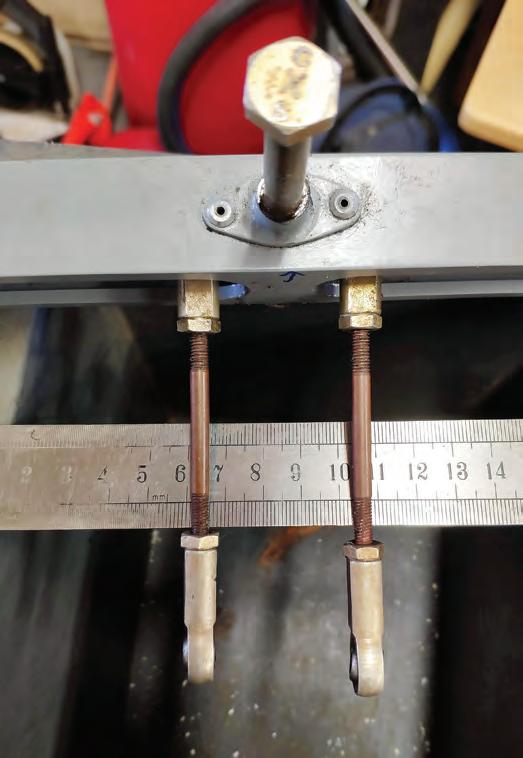
I hope that you can see from the picture that, especially with such a small diameter bolt as this, the hole for a split pin removes a considerable part of the cross-sectional area of the bolt’s threaded portion. Of course, the sharp edges in the material will act as a near-perfect stress-raiser. A drilled bolt must never be used in any installation where the load is applied to the piece of thread that’s weakened by the hole.
Hexagonal head AN bolts are manufactured with and without wire-locking holes, because this bolt was secured into a locking anchor-nut, there’s no need for wire-locking, so the bolt should have been an AN3 -XXA, where 3 is the size in 1/16ths of an inch, the first X is the length in inches, the second X is eighths of inches and the A (Absent), means no locking wire hole.
We received a call from LAA Inspector Roger Benson, letting us know that he’s found a potentially dangerous control system issue on a Kitfox Mk 2 that he’s managing the repairs on for the owner. “Repairs, what’s happened? There’s nothing in our database to suggest that there’s anything amiss with this airframe,” I said. Roger explained that back in July, this aircraft ‘took a tumble’ and ended up on its back. The damage was minimal, although both wing struts needed either replacing or repairing … “We’ve put in a repair application for that.”
During the deep inspection, always required after any kind of incident of course, Roger found that a bolt’s shank was fouling in the flaperon mixer box – the reason for this is simply that the system



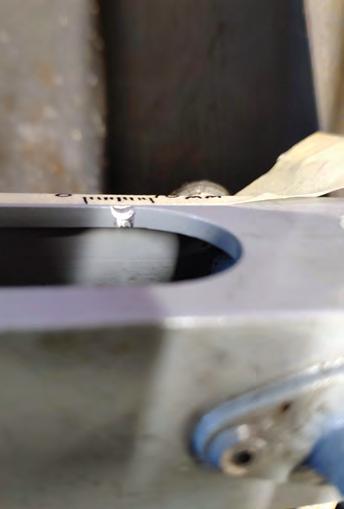
. Photos: Roger Benson
hadn’t been rigged correctly sometime in the past. Perhaps adjustments were made to one flaperon to correct a roll, there’s nothing in the aircraft’s log book to suggest when any adjustments were made. Good spot Roger.
You can see from the pictures above where this bolt was catching, thanks Roger for sending them.
I then called the owner to find out why the aircraft had ended up on its back and, naturally, reminded him of his obligation to report an incident like this both to AAIB (a legal obligation) and to LAA Engineering (a sensible action). The owner explained that he had flown a cross-country flight from Bodmin to Eggesford and commented that the day was extremely thermic and very hot. Eggesford’s east-west runway has a hump roughly a third of the way in when landing towards the east. The wind was about 150˚ gusting about 10kt but averaging about five.
From the pilot’s point of view, this puts the wind at about 40˚ from the right, so about three-quarters of the wind should be considered cross – well within the normal limits for a Kitfox.
Unfortunately, just as the aircraft touched down on the brow of the ‘hump’ the aircraft ‘caught a gust’, probably a thermal passing above the site, the tail lifted, and directional control was lost.
The aircraft inverted as it ran, quite slowly as it turned out, into long grass at the side of the strip.
We’ve seen quite a few incidents ‘post-lockdown’ where the hot weather, crosswinds, and quite thermally conditions, have played a part in a loss of control on landing. Fortunately, the damage to this Kitfox was repairable and maybe, since a potential inflight jam case has been avoided because of the diligence of an LAA Inspector, the long-term future for this aircraft and its owner are much rosier. Fair Winds. ■

Billy and Mary Grant have been Highlands and Islands Strut treasurers for 45 years and also arrange the Strut’s Dornoch fly-ins.



It has been a real joy over the last few weeks to listen to the sound of light aircraft buzzing around again. The weather has been mostly kind for those who fly, indecently hot for some of the time, but giving us the opportunity to fly into airfields that offer a cold drink or ice cream!
Thank you to all the Struts who have shared stories relating to the revival of fly-ins, BBQs and other activities.
The Highland and Islands Strut were pleased to report that grass cutting on the Dornoch airfield had been resumed by the Royal Dornoch Golf Club greenkeepers, and that members from the Strut and flyers from Inverness Airport and other local airfields, and from afar, had once again taken to the skies. Nigel Campbell wrote, “There are currently 42 of our 88-strong Strut membership registered as having an
aircraft. We extend our thanks to Strut members Billy and Mary Grant who have not only been Strut treasurers for 45 years, but have also made all the arrangements at Dornoch airstrip, seven miles north from Easter, to prepare for our annual fly-ins. Regretfully our Strut’s annual fly-in at Dornoch this year was cancelled due to Covid.
However, Easter Airfield, just north-east of Inverness, held a well-attended solstice fly-in. There is a delightful shepherd’s hut at the airfield provided by owner/operator David Munro for visitors to overnight. This is an excellent and well-run airfield, with just a fiver for landing, and is well worth a visit!”
An Inaugural World Tour of Yorkshire was held by the Vale of York Strut at the beginning of August to encourage pilots to visit as many of the local airfields as they could.
Seventeen aircraft, a mix of LAA types, weight-shift and three-axis microlights and CofA types took part. The Strut enjoyed a BBQ at Eddsfield and a visit to the Yorkshire Air Museum with its 3,000m runway at Elvington. From memory, I think it is possible to land a Cub across the runway at Elvington as well as along it! Congratulations to Chris Holliday and the Vale of York Strut on an imaginative initiative.
The Oxford Group descended on Enstone Airfield for a Strut BBQ. Geraldine O’Meara wrote, “It was great, and rather surreal, to meet up ‘in real life’ again – even more surreal to meet wearing masks. Paul kindly gave us the use of his huge hangar at Enstone, which allowed us to keep well apart even during the lashing rain that is the all too frequent accompaniment to the Oxford Group summer BBQ. Paul and Angela provided delicious food and the evening was a resounding success.”
Meanwhile down at Henstridge, the Wessex Strut opted for a Spaghetti Night. Neil Wilson reported, “A very pleasant
Wevening was spent at Henstridge one Saturday evening (after lockdown was lifted) sitting outside on the many well-spaced new benches that have now been provided. Four members flew in, including Dave Millin and Mike Mold from the Devon Strut. It was nice to see people again. Thank you to Geoff Jarvis and team for the food and hospitality. Let’s hope we can all get back together soon.”
Perhaps we could spare a thought for Paul Lawrence and the Rally Workers’ Strut. After a year off, plans for a celebratory 75th Anniversary LAA Rally will ensure they are kept busy in 2021!
Other Struts report on ongoing builds during lockdown and many are starting to think about a way of continuing meetings into the autumn. However, numbers may need to be restricted and our friend ‘Zoom’ may start to reappear in the listings. It’s at times like these that we realise the true value of our gatherings and how much we appreciate meeting up with fellow enthusiasts to share our common preoccupation with flying machines.
hen a programme of talks and meetings resumes, we will publish it as before. Meanwhile, you can remain in touch with your local group by using the contact details below.
Andover Strut: Spitfire Club, Popham Airfield, SO21 3BD. 1930. Contact keith. picton@ntlworld.com
Bristol Strut: BAWA Club, Filton,1930. Room 4. Contact chairman@bristolstrut.uk www.bristolstrut.uk
Cornwall Strut: The Clubhouse, Bodmin Airfield. Contact: Pete White pete@aeronca.co.uk 01752 406660
12 September Cornwall Strut Fly-In.
Devon Strut: The Exeter Court Hotel, Kennford, Exeter, 1930. Contact: david.millin@sea-sea.com
East of Scotland Strut: Harrow Hotel, Dalkeith. 2000. Contact: inrgibson001@ btinternet.com 0131 3392351
East Midlands Strut: Currently meeting on the second Monday of the month via Zoom, please contact: tonyrazzell2@gmail.com for meeting details a few days before hand or to be added to our email circulation to get details automatically. We also have a Facebook group and upload recordings of meetings where we have speakers. Gloster Strut: The Flying Shack, Gloucestershire Airport 1930. Contact: harry.hopkins@talktalk.net
Highlands & Islands: Highland Aviation, Inverness Airport. Contact: b.w.spence@ btinternet.com / 01381 620535
4-6 September – Easter Fly-In.
12-13 September – Glenforsa Vintage Fly-In.
Kent Strut: Cobtree Manor Golf Club, Maidstone, Kent. 2000 Contact: Brian Hope bfjjodel@talktalk.net Currently having Zoom meetings last Thursday of the month, please
We will continue to share Struts4U stories and how you are managing during these difficult times. I am always happy to hear your news and views, please feel free to email me with any relevant information at struts@laa.uk.com
email for details a few days in advance.
LiNSY Trent Valley Strut: Trent Valley Gliding Club, Kirton Lindsey. pilotbarry1951@gmail. com http://linsystrut. wixsite.com/website
North East Strut: Fishburn Airfield. Brunch third Sunday of each month 1130-1330 at Fishburn Aviator Cafe. Contact: alannixon297@btinternet.com
North Western Strut: Veterans Lounge, Barton, Manchester, 1930 for 2000. Contact: cliffmort@btinternet.com / 07813 497427
North Wales Strut: Caernarfon Airport, Dinas Dinlle, HEMS Bistro Café 1300.
Contact: Gareth Roberts gtrwales@gmail.com / 07876 483414
Oxford Group: The Duke of Marlborough, Woodleys, Woodstock, Oxford, 2000. Contact: LAAOxford@gmail.com www. oxfordlaa.co.uk
9 September – Hangar Talk at Enstone Airfield by LAA engineers Joe Hadley and Mike Roberts.
Redhill Strut: The Dog and Duck, Outwood, Surrey, RH1 5QU. Third Tuesday each month at 1930. Contact: david@milstead.me.uk Shobdon Strut: Hotspur Café, Shobdon Airfield, Hereford HR6 9NR. 1930. Meetings (once lockdown completed) second Thursday of month. Contact – Keith Taylor bushebiggles@sky.com
Southern Strut: The Swiss Cottage, Shoreham-by-Sea, 2000. Normal meetings are on the first Wednesday of the month. Contact palmersfarm@sky.com
Strathtay Strut: Scottish Aero Club, Perth Airport, Scone. Scone Clubhouse. Contact:
keith.boardman@peopleserve.co.uk / 07785 244146
Suffolk Coastal Strut: Crowfield Airfield Clubhouse. 1900. Contact: Martyn Steggalls events@suffolkcoastalstrut.org.uk / 07790 925142
16 Sept 1930 Virtual meeting over zoom. Talk on Hot Air Ballooning by Robin Macey. 21 Oct 1930. Virtual meeting over zoom. Subject TBA
Vale of York Strut: 1900. Chocks Away Café, Rufforth East Airfield. Contact: Chris Holliday 07860 787801 / cwaholliday@gmail.com www.valeofyorkstrutlaa.wordpress.com
17 September – Checklists, Paperwork and a trip to France. (Numbers limited/ livestream available)
Wessex Strut: Henstridge Airfield Clubhouse. No club meetings until further notice. Contact: neil.wilson@laa.uk.com
West Midlands Strut: Navigator Café, Halfpenny Green Aerodrome 1930. No meetings until 2021. Contact Graham Wiley westmidlandslaastrut@googlegroups.com
Stuart Darby stuartdarby134@hotmail.com or visit our website wmstrut.co.uk
West of Scotland Strut: Bowfield Country Club, Howwood, PA9 1DZ. 1900.
Contact: Neil Geddes barnbethnkg@gmail. com / 01505 612493
Youth & Education Support (YES): Contact for further details – Stewart Luck captainluck@hotmail.com
NB:Thank you to all Strut co-ordinators and newsletter editors for the continuous flow of information. You can contact me at struts@laa.uk.com

Welcome Toby, could you tell us something of your working life?
I grew up initially in Filton, Bristol and then moved to Frampton Cotterell, so dad had a garden big enough to rig an aircraft. I went to The Ridings High School, but when I started my A-levels I quickly realised it wasn’t for me. The only way to jump ship with my parents’ approval was an apprenticeship, especially in aviation, so I joined Filton College / Aviation Services at Filton Airfield for an aviation engineering apprenticeship leading to a ‘Section L’ licence without type rating (LWTR).
The course initially comprised one day a week at Filton College doing various BTECs, one day in the Aviation Services Technical training department doing City and Guilds, and three days a week in the Airbus workshop making various components, machining and welding. The course then went on to three days a week in the hangars on the Airbus A300 freighter conversions. For the third year college ended, so time was spent in the hangar. It was meant to be a four-year long apprenticeship, but Aviation Services went bankrupt so a few of us did the fourth year theory work and exams in an accelerated course (four weeks) for airframes. I then went on to do the CAA oral exam and obtained a restricted Part 66.
The big jets were not my cup of tea, so I went to Eurojets at Staverton working on twins and single pistons and a DH Dove. When that company moved to Birmingham, I took up an offer from Roger Targett and moved to Targett Aviation at Nympsfield, where I am currently.
We carry out maintenance on a small number of gliders, but the bulk of our work is the repair of LAA and BMAA types such as Eurostar, C42, RV, Dynamic etc. For example, at time of writing we have an Aquila for annual, Starduster Too for repair, RV-7A for repair, RV-7A for repair
This month we talk to Toby Willcox, aircraft engineer and microlight and light aircraft pilot…
Above Toby Willcox in the rear seat of Pete Watts’ retractable Jurca Sirocco, G-CEAO, one of his favourite aircraft.
and conversion to a taildragger, a Tipsy Nipper for a little spruce up, with a Venture, Eurostar, Dynamic, Jabiru J400 and Europa waiting to come in. We also maintain a few CofA types.
What started your interest in aviation?
I was fortunate to be born into it. While still at school, dad used to hitchhike to Bidford Gliding Club where he would drive the winch all day to get free launches. From flying gliders, he headed to the RAF where he flew Chipmunks, Jet Provosts, Gnats and Hunters.
When he came out he moved to Bristol and flew GA but couldn’t afford to do a lot, then one day passing Filton Airfield he saw a small blue aeroplane taxi out – it was the MW4 about to make its second flight. Two years later he met Mike Whittaker, which led to him building an MW5 G-MNXY, MW7 G-BOKI and MW6T G-MZOK.
As a youngster I sat in fields for hours watching dad and Eddie Clapham’s shenanigans and wanted to be as good as either of them when I grew up, which has driven me to fly as much as I can to try and achieve that.
In what, where and when was your first flight?
At the age of six dad took me for a flight in Eddie’s MW6T, G-MNMW. We didn’t get a two-seat aircraft of our own until I was about 16, but I flew regularly – and I became adept at bumming rides. The MW6 was built by Mike, Eddy and Steve Slade, all of whom have greatly helped me along the way.
Where did you learn to fly?
I flew our MW6 regularly with dad, so by the time we could afford lessons I was quite proficient. I did my PPL at Kemble Flying Club with Dave Young and John Melville in an AX3, G-MYGD.
Later, I went to the Cotswold Aero Club with Phil Mathews, for an NPPL SSEA rating in PA-18 G-OVON, and

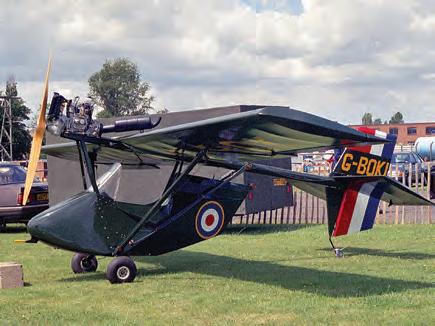
retractable undercarriage and variable pitch propeller
Differences training in a PA-32R G-VONS. More recently I have done my EASA Aerobatics rating in a Citabria with Dave Jelly at Freedom Aviation at Kemble.
Did you find converting to tailwheel aeroplanes difficult?
I have to confess I didn’t really think about ‘converting’ as such. I was young and questionably stupid, I guess. My friend wanted to hear and see his 912 Rans taildragger fly from the ground as he never had so I jumped in and flew it, I found it quite straightforward. The next taildragger I flew was an Avid MK4 – and that needed a bit more footwork!
It is a bugbear of mine when I hear people say that they would like to give tailwheel a go but have been put off by people telling their horror stories. It shouldn’t be the case, if you are doing a three-point landing, the only thing in the whole flight that differs is that you push the stick forward on take-off once rolling, the rest is the same.
The only thing with a taildragger is you have to use all the skills you were taught in training all the time, which can make it feel frantic at first, but like anything else, it eases with practice. Think about when learning to fly, when you had to start using the radio at the same time!
Someone I know recently told me he was put off tailwheel aircraft. Being a bit grumpy at the time I roasted him for listening, he went and did his conversion and absolutely loves it now.

Top Another of Toby and his dad’s favourites, the Skyranger, which is a ‘go anywhere’ aircraft that will operate out of little more than 100m.
Above left Toby and his dad have a long history with Mike Whittaker’s MW series, his dad having built three, including MW7, G-BOKI.
Above right With Eddie Clapham and Turbulent G-ASFX, which Eddie and Bill Dobie built and flew for over 50 years before Bill retired from flying and sold his share to Toby.
I grew up with the PFA as dad built the MWs and have been a member in my own right since 2009, when I bought my Minimax G-BYJE.
How many aircraft have you built/owned?
I built two Skyrangers with dad, but at work I have rebuilt too many other types to remember. I have the Minimax, which for the money is a cracking aeroplane, but like my Quantum 912 flexwing it is unused due to lack of free time.
I recently got to fulfil a childhood dream and took on a half-share of Eddie Clapham and Bill Dobie’s Turbulent G-ASFX. I have known the aircraft all my life and was thrilled when my gentle pestering convinced Eddie to convince Bill to sell his half. I see myself as the current custodian of a piece of history – I shall keep it for as long as I can get into it.
I am also slowly rebuilding an RV-9A that I bought as salvage and I am converting it to a taildragger. And I also own most of the bits of a Chaser flexwing.
Other aircraft I am fortunate to be able to fly are a Jurca Sirocco, Acrosport 2, Chipmunk, PA18-95, Rans S6S, Thruster T300, and a Skyranger.
How has the LAA helped you?
Massively. I call / email the office almost daily and, although at times they are incredibly busy, they are always helpful.


How many hours and types do you have in your logbook?
I have 1,468 hours and 74 types logged P1, not including variants of the same type. That’s made up of 38 microlights, 10 of which are flexwings, and 26 light aircraft. I have also been fortunate to have been flown in other interesting types such as the Aeronca C3.
Do you have a favourite and not so keen on type flown?
It’s hard to single one out a single type, but the Turbulent provides so much fun and the controls are a delight.
On a hard runway with no wind, it is anyone’s guess what will happen below 15mph as the rudder fades and the tailwheel casters. Being a bit of a tight cockpit, the brakes are fun to find, and as the mains are well back, if you brake too hard, you’ll need a new prop! It makes me laugh when it all happens, which is part of the fun for me. However, the low power / low weight means you do have to respect it.
The Jurca Sirocco is another real favourite. Again, fabulous controls and impeccable manners as long as you respect it. Although the stall speed is high it’s not a terrifying experience, but it does tend to fly or fall.
Practice forced landings are fun as the descent rate dirty is impressive, and you have to carry a lot of speed as the one thing it does not like is fast high angle of attack changes. On take-off it just follows the prop and if you do powered approaches it will nearly always three point and run straight.
I have only got it wrong once and caused it to drop the wing due to my poor speed management over the threshold – typically, in front of lots of people at the Henstridge LAA meet! It is easily recovered with power and unloading the elevator.
The real old faithful is the Skyranger Swift. You can take it anywhere and land anywhere – France, Scillies, Lundy or your mate’s back garden if it’s little over 100m. It is a fantastic workhorse.
Recently I flew a Tipsy Nipper and a Flitzer – they are real smile makers. And finally, of course, MWs. They made everything I do today happen and taught me so much.
Worst? I’m not going there as I do not want to knock someone’s pride and joy. However, I have come across aircraft that have a terrible reputation, but I seem to like them! The Tiger Cub springs to mind, I was warned not to fly it but I did. It was great fun and, without a doubt, quirky.
I actually have three stand-out moments in my flying life. Completing the first flight of the Stroud school Build a Plane Rans S6 and flying it in to RIAT 2014 is one. The RIAT flight made it for me as the controller informed us we would be backtracked upon landing. I briefed my passenger that I would be landing slow on the piano keys, which we did, and stopped by the numbers. The controller came back and said, “Well done G-AP that is by far the shortest landing Fairford has ever seen”.
Completing the post-repair check flight on the Fieseler Storch replica G-BZOB, flying down the Cotswold escarpment looking at people stopping and pointing, was a second.
But the saddest, yet most worthwhile, thing I have ever

done was the fly past of the hospice where a good friend, Jim Taylor, was for his last few days. He had asked if the lads from Over Farm would do a fly-by in the two Skyrangers he’d built, however he didn’t expect to see his current Eurofox, G-CHID. I made sure he saw me as I knew it would be the last time. I will never forget seeing his frail arm wave. When I landed he rang to thank me, and that was the last time I spoke to him.
Do you have any aviation heroes?
I have the greatest respect for Mike Whittaker for designing aircraft that made it possible for people like my dad to build, and to give me the path into aviation.
Eddie Clapham for all the time he gave us as the Inspector to help dad, and all the flights I had as a child in his aeroplanes. Plus, all his achievements that have helped a lot of what we have today. Nigel Beale for providing the microlight community with Rotax engines through the tough times, and then the 912 which changed everything.
Also, the late Tim Cox for all his help and support over the years and his workmanship. And of course, my parents. Neil Williams, no explanation needed. Steve Jones, as the most memorable display I have ever seen was at Goodwood when he was in a Spitfire glued to the wing tip of a Mustang. For aircraft of different performances it was a fantastic sight.
Above Toby is very much an all-rounder, everything from high-performance light aircraft to SSDRs, such as his self-built Minimax, G-BYJE.
Left top G-BZOB, a Slepcev replica Storch that Toby enjoyed making the post repair check flight on.
Left Flexwings also have a place in Toby’s heart, this his Pegasus Quantum 15-912, G-BYFF.
I confess to a few, and if social media had existed everyone would know about them, but staying calm and fighting the panic instinct got me out of them, hopefully never to revisit.
One flight that still makes my hair stand on edge is when we were heading northwards with the intention of going via Ince to Eshott. Passing the hills to the east of Welshpool and under total lowering cloud cover, we ended up in a bowl, circling. Up to that point I was happy thinking we’d follow a valley out, but this closed in, leaving us trapped. With little chance of landing it was looking bad. Then we saw a little light patch, taking it we burst out into beautiful weather and diverted to Welshpool, who were excellent. The entire time I had dad beside me (rightly unhappy for allowing me to do this) and the thought of what could of happened still haunts me. Lesson learned, turn back, stupidity does not always win – and Mother Nature is beyond your control, no matter how good you think you are.
Do you have any non-aviation hobbies and interests?
Not unless it’s raining or windy! I might ride my push bike and most recently I did a track day at Donnington Park, of which I would like to do more. I have built RC aircraft on and off for most of my life and have an impressive collection, but don’t get to fly them as often as I would like.
What’s on your aircraft or vehicles wish list?
A Bucker Jungmeister but my girlfriend, who also flies, always points out it’s a single seater, so it’s now a Jungmann. And on four wheels it’s a Ford GT40.
What aviation books would you recommend
I confess to reading very little other than aircraft manuals, but I have read Neil Williams’ Aerobatics and Alex Henshaw’s Flight of the Mew Gull
Finally, what advice would you offer pilots?
If you think you want to, do it no matter what, tailwheel conversion, aerobatics, short field coaching, just do it. We already know life is short, but this pandemic has proven that time can be shorter, even with perfect health. ■

 By Steve Slater
By Steve Slater
We all know the frustrations when road works reduce motorways to just a single lane each way. In the inevitable tailbacks, there are of course increased risks of collision as frustrated drivers are forced into closer proximity.
In the air, the consequences of any such collisions are much more serious, which is why we continue to be so concerned at the proposals by RAF Brize Norton and London Oxford Airport to sequestrate a large area of lower-level airspace in the heart of the country for controlled airspace. It will inevitably create pinch-points and an increased risk of collision among pilots attempting to circumnavigate the aerial road block.
Some may remember the furore in 2017 when Farnborough carried out its infamous airspace ‘smash and grab’.
One of the results was that the CAA changed the consultation process on 1 January 2018, implementing a revised, more transparent, CAP 1616 Airspace Change Process. One of its key differences is that the ‘airspace change sponsor’ is required to look at the safety impact on the wider airspace around it, not just the controlled airspace itself.
However, Osprey CSL, consultants to Brize Norton and Oxford, rushed the initial stage of its proposed changes through before the CAA changed its code, avoiding the requirement for such due diligence. The result was a hastily prepared proposal, with the minimum of appropriate impact assessment, scraped together at the last minute to meet the deadline before the now discredited process was changed. Then, little happened for more than two years.
So now, after such a long delay, perhaps it is logical that these changes should be reviewed and judged to the newer, safer, criteria. Certainly, that’s the question we are now asking of both senior CAA airspace managers and the Department for Transport.
Another airspace development which was highly unpopular at the time, was the 2015 increase in airspace around London Southend (sic) Airport. Designed to accommodate a planned surge in passenger traffic from airlines such as easyJet wishing to avoid larger airport charges, it featured a significant increase in controlled airspace between 1,500ft and 3,500ft.
Since then, pilots in Essex and North Kent have had to maintain look out for a significant increase in transit traffic avoiding the controlled airspace. This month, easyJet has announced that they are now pulling out of Southend as part of its post-Covid recovery plan. While I feel sad for the crews, ground staff and the controllers at Southend whose livelihoods may be at stake, perhaps now is the time for a proper review of their alleged requirement for more controlled airspace than Gatwick.
All these issues suggest strategic failures in airspace governance that we’ve long been pointing out to the regulator and DfT, so it is welcome news that the CAA has launched a further consultation on its procedure for reviewing the classification o f airspace. The consultation closes on 17 September, and such is its importance, that we are preparing an LAA response, and contribution to a GA Alliance response, and we hope LAA members will contribute to the consultation too.
The consultation can be found by searching CAA CAP 1934, or for a shorter version, CAP 1934A. Basically, the documents refle ct an instruction from the Secretary of State for Transport that the CAA implements a new procedure to review, and where appropriate amend, airspace classifications, determining the flig ht rules that apply in that airspace and the procedures that must be followed.
While it is clearly a complex issue, reflecting the need for different, sometimes competing factors to be taken into account, our prime interest is that the amount of controlled airspace should be the minimum required to maintain an appropriate standard of air safety, and that the needs of all airspace users are reflect ed on an equitable basis. Instead of a constantly increasing ratchet, we need to rapidly identify and reclassify areas of controlled airspace that have no safety or traffic management benefit.
Whether that can be achieved is open to some debate, given the CAA’s performance in equitably handling past Airspace Change Proposals. Meanwhile, their consultation earlier this year in attempting to create a reclassification priority list was har dly a model of transparency, simplicity or plain English!
We have for the past few years advocated that the CAA’s performance in this area may be better overseen by an independent ombudsman. Perhaps this latest consultation can be seen as a step in the right direction by the CAA. Alternatively, we will renew our calls for a better, more transparent process either within, or independent of, the CAA.
Meanwhile, back at base we’ve got most of our staff now working in the Turweston offices after a COVID-Safe programme to ensure appropriate distancing, cleaning and screening, to minimise any infection risks on site. A massive thank you to all, both for their efforts while working from home and on their return to office working.
However, one further COVID-19 casualty has been our plans to host a ‘face-to-face’ AGM at Sywell on 18 October. As you’ll read in this issue’s News pages and in our Chairman’s column, we’ll now be running this online, via Zoom teleconferencing, and we’ll release more information in next month’s magazine. A bonus is that it will enable a wider debate session and general discussion after the end of the AGM, so please drop any items for discussion to me via office@laa.uk.com ■





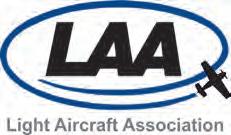

Rans S6S Sport. This unique Rans 912UL powered S6 has been upgraded to 499kg and covered in conventional Ceconite fabric. Additional cabin panelling - the most luxurious S6 in the UK. Only 20 hours with a current Permit to Fly. May be seen at Milson, Worcs. OIRO £32,000. Contact David Bedford, DBedford1@btinternet.com
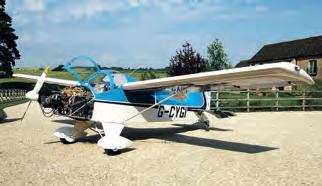
HAPI Cygnet SF-2A project for sale. Almost complete (see photo) but ill-health forces sale. Powered by new Rotax 912. Instruments provided but not yet fitted. Sensible offers invited. Please email gcygi.sale@gmail.com for more information.
I need a project! I’m a ‘repeat offender’ with an empty workshop. If you have a project that’s lost its appeal or know of something interesting in pieces and available at the back of your hangar, please contact me at bob@rgfairall.co.uk . Oh, and please, if the paperwork is not 100% or it’s been outside in your garden since 1962 and has a tree growing through the wing, I’m sorry to say it’s not for me.

Exceptional Jurca Sirocco project 85% finished for a discerning builder. For more info and photographs call James: 07595 231985 or email: james@trafmar.com
Also, hangar space for two aircraft available at Kittyhawk Aerodrome, BN8 6BB.

Lancair 320 MK2. Rare opportunity G-PJMT for sale with the benefit of full aircraft conversion / tuition to confidence by QFI/FI owner. Meticulous and proven build, always hangered, professionally maintained, owned since January 2005, TTAE 840 hours. For full aircraft history/ specification/photographs. £74,450 No vat. Please contact paul8320gilroy@btinternet.com
The Design of the Aeroplane by Darrol Stinton. Granada 1st Edition, as new. Price to LAA member £30 plus £5 p&p. email Peter at cav-ok@outlook.com
Plans, full set of unused Sequoia F8L Falco drawings and manuals, free to collect by LAA member. Email j.maxwell3@me.com

Enstone based hangered PA17 Vagabond. 1/10 share for sale. This aircraft is a delight to fly and is operated and maintained under an LAA permit by an enthusiastic syndicate. Built July 1948. Airframe 8878 hrs. Engine Continental 90hp 953 hrs SMOH. 20 litres per hour. Hercules 70” x 46” wooden prop. £2,000. Further details contact Asger 07801-457449. Email: asgermobile@yahoo.co.uk

Sherwood Ranger ST (Microlight). Half share offered in G-YELP, hangered north of Winchester. 142 hours Jabiru 2200A engine. ATR833 radio, TT21 Mode S transponder. Road trailer. Offers invited. Further details: cb@peachhouse.co.uk
One fifth share in excellent Sywell based Robin DR400 180 Regent. £13000. £180/month plus £95/hr. 1890 airframe hrs, 145 hrs since full engine rebuild. Telephone Neil 07801 613 193 for full details.

Fournier RF4, G-BHJN. 1/8 share in friendly long-established syndicate. £3,500 ono. Based Enstone EGTN. One of the most delightful aeroplanes you could fly. Frugal, soarable and aerobatic. £45 pcm and £30 ph wet. Call Jules 07718 257551 or jules@theskyisblue.net
Engine wanted for Supermarine S5r seaplane project. Continental IO-360 200hp six-cylinder, fuel injection. Must have good compressions. all accessories + propeller. Must have all logs and full history. Please contact Will Hosie 07585 663670 www.supermarineseaplane.co.uk
France, Loire. Montrichard private airfield. Hangarage for two aircraft, four-person cottage. Package designed by flyers for flyers. £700 per week. www.lachaumine.co.uk
Tel 07802 217855 or 01424-883474.

JPM, Oil filter adapters. Made to order, Continental O-200 -12 £320 and A65-8 from £390. Will help with Mod paperwork. These adapters replace the oil screen assembly. jpm.aviation@ gmail.com Julian Mills 07976 530563
Lucas SR4 twin magneto installation, mounting plate, sprockets, duplex chain, period switches, screened LT wiring, spare magneto, Lucas instructions, original full size Peacock VW engine conversion blueprints, £250. 07811 010170.
Solex 32-PHN-1 VW carburettor (DPB 7179, VW1-3) plus full overhaul kit, alternative main jet and selection of air correction jets. Bought as a good spare but untested. £130. 07811 010170.
Dittel KRT2 8.33 aircraft radio, in good condition and with very good performance. Built-in intercom system and good in the air range. The present selling price new is around £940. My price £550. If interested contact David Walker at dnswalk55@hotmailuk.com.or 01344 422151.
Welding services (mobile). CAA approved for 4130 steel airframe manufacture and repair. Custom exhaust systems and aluminium fuel tanks undertaken. Manchester based. Contact Julian Mills, on 07976 530563
Two new Skytec starters – 149 12PM and 149 12LS. Unused, perfect condition, all paperwork available. Neither would fit under my cowling, £310 each. Also new, unused 8000075 Oil Cooler – mounting lugs removed at opposite end to feed/ return. £275. Angus 07767 763 296
Design & Stress Analysis Service. Type submissions, modifications, and general advice. We cover structures, powerplant (IC and electric) and avionics. Ex-Chief Stressman and Part 21J Head of Design.
Contact John Wighton enquires@acroflight.co.uk or call 07770399315.



1 x O-200 all major components NDT. No pistons and 1 cylinder only (as photo). 1 x O-240 complete engine disassembled with magnetos. Crankshafts - NDT but not dimensioned: 2 x C85. 1 x A65. 1 x O-200. Crankcases: C90/O-200. A65. C85-12F. Sumps: C86/C90. Rear Covers: C85/A65. 2 x new O-200. Many miscellaneous spare parts. tel: +44 (0)1884 855327 email: arrowaviationdevon@outlook.com

Telephone: 0121 327 8000
E-mail: info@ponsonby.co.uk
Web: www.ponsonby.co.uk

Contact us now for a quotation


